- Cruising Compass Media Advertising & Rates
- Blue Water Sailing
- Multihulls Today
- Subscribe Today


Outfitting Your Sailboat for Safety at Sea
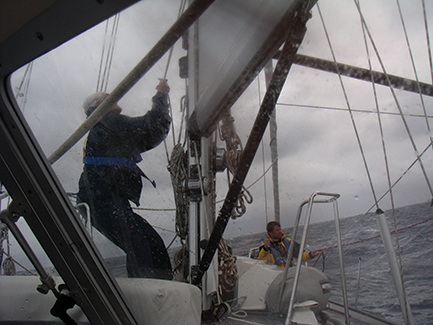
With the amount of gear and opinions available on what you should or should not have, fitting out a sailboat for blue water has never been more daunting. Couple that with the highly personal nature of the seamanship and safety decisions that need to be made, and getting a boat ready for offshore work can seem like a major obstacle to attaining the cruising dream. But it doesn’t have to be.
When cruising sailors talk about fitting out their boats for adventures on the high seas, the focus usually seems to be on big ticket items or creature comforts: a new dinghy and outboard, rigging, refrigeration, self-steering, wind and solar, etc. But there are a handful of safety considerations to take into account when preparing your boat and crew for the rigors of ocean sailing.
The International Sailing Federation (ISAF) and U.S. Sailing have been leaders in the safety at sea movement for many years, and as such, have developed a set of safety recommendations for what offshore quality yachts and their crews should have aboard when heading out over the horizon. Many of their recommendations are required for entry in offshore racing events, but cruising sailors can easily look at them as a helpful set of parameters to follow when outfitting for their own coastal or offshore passages. In the end, how you choose to outfit your yacht is entirely up to you. The following is meant as a helpful starting point when turning a weather eye towards fitting out for safety.
WHO’S IN CHARGE? ISAF begins their Offshore Special Regulations with a call to action for the person in charge of the vessel: “The safety of a yacht and her crew is the sole and inescapable responsibility of the person in charge who must do his best to ensure that the yacht is fully found, thoroughly seaworthy and manned by an experienced crew who have undergone appropriate training and are physically fit to face bad weather. He must be satisfied as to the soundness of hull, spars, rigging, sails and all gear. He must ensure that all safety equipment is properly maintained and stowed and that the crew knows where it is kept and how it is to be used. He shall also nominate a person to take over the responsibilities of the Person in Charge in the event of his incapacitation.”
This statement speaks volumes about how a sailboat and crew should be prepared before heading offshore, and based on the amount of people, including couples, who are taking sailing and safety courses and seminars these days, they are on to something.
GEAR FOR THE BOAT Choosing an offshore quality boat is the start of safely crossing large bodies of water and there are plenty of resources and opinions floating around to help with that decision. Deciding on a boat is highly personal, though, so we’ll assume you’ve done the best in choosing the boat that is right for your cruising plans.
Moving to dedicated safety equipment, having a quality life raft that is up to date on certification and designated for the amount of crew you have aboard is critical. With that, you should also have a properly supplied grab bag (see sidebar) to take with you into the life raft.
For crew safety while sailing offshore it is imperative that you have properly installed and rigged padeyes and jackstays/jacklines. The purpose of clipping points other than the jacklines is to allow for most, or all, crewmembers to be clipped in at the same time. The recommendation has also been made for crewmembers to be able to clip in before they come on deck and unclip when they get down below. Also, Dyneema or Spectra type line has been approved for use as jacklines and lifelines if they are spliced using the manufacturers recommended procedures.
In the event of a crew overboard situation, it is recommended that your boat be equipped with a throwable lifebuoy that has a 50 to 75 foot line attached to it and the boat. It is also recommended to have a GPS at the helm station with a man overboard button that will plot their position when pushed, and a waterproof high-powered searchlight to look for the person at night.
Other recommended safety items include; a storm jib with high visibility cloth or tape, a radar reflector, foghorn, first aid kit and manual, fire extinguishers, fire blanket near the stove, soft wood plugs, emergency water supply, flares, drogue or sea anchor, waterproof flashlights, and a full compliment of tools and spare parts.
That amounts to a lot of gear and a lot of dollars from the bank account, but there are plenty of stories to suggest that all these things could save your life.
In addition to a PFD, harness and tether, it is recommended that each crewmember have a knife, waterproof flashlight, and appropriate foul weather gear with marine-grade reflective material on it.
NOT JUST BUYING GEAR Responsibility and safety aren’t all about buying gear. Knowledge and experience play a major role in safety at sea and there are numerous safety at sea seminars and classes available. U.S Sailing’s Safety at Sea Seminar offers a mix of lecture and hands on learning that are helpful for anyone who is planning to go offshore. Lecture topics include emergency communications, personal safety gear, man overboard, search and rescue procedures, large vessel traffic, heavy weather, breaking seas and more.
Aside from U.S. Sailing’s Safety at Sea seminars, many sailing schools, offshore rallies and races have safety classes, symposiums and seminars designed to help those who want to sail offshore gain a strong foundation of practical safety knowledge before shoving off.
It has been said many times over that safety at sea is no accident. The truth in that speaks to absolute preparedness and the need for essential safety equipment when fitting out your boat and crew before heading offshore. Having a vessel and crew that are well founded, equipped and ready to take on the rigors of ocean sailing will not only give you peace of mind before cutting the dock lines, but could save lives if the unexpected happens.
Resources: US Sailing’s : offshore http://www.ussailing.org/education/safety-at-sea/ ISAF: www.sailing.org Marine Trades Association of Maryland: mtam.org/safety-at-sea.html Marion to Bermuda Cruising Yacht Race: www.marionbermuda.com/sas/sasreg.php
RECOMMENDED GEAR FOR YOUR GRAB BAG
Spare sea anchor (larger than the one packed in the raft) Second sea anchor for the life raft (if not already packed in life raft) Waterproof handheld VHF Radio with spare batteries A signaling whistle Fishing tackle Extra sponges Plastic bags Repair kits capable of working when the raft is wet Two red parachute and Two red hand flares (SOLAS compliant) and cyalume-type chemical sticks Handheld GPS Search and Rescue Transponder (SART) Water in re-sealable containers or a hand-operated desalinator plus containers for water A watertight flashlight with spare batteries and bulb Dry suits, thermal protective aids, or survival bags Two safety tin openers First-aid kit including at least 2 tubes of sunscreen. All dressing should be capable of being effectively used in wet conditions. The kit should be clearly marked and re-sealable. High energy food Nylon string EPIRB/PLB Knife Seasickness tablets (min 6 pp recommended)

Administrator
You might also like.
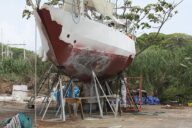
Problems with Paint Application Q & A

Dinghy Security

Winterizing Your Engine

Read the Summer-Fall Edition of Blue Water Sailing
Read the fall 2023 edition of blue water sailing, recent posts.

- Introducing the New Dufour 44 Modern Family Cruiser
- Cruisers Rescue Frantic Castaways off French Coast

- The 37th America’s Cup Defense Begins in August: Here are the Important Dates
Please Visit Our Sponsor’s Webpages
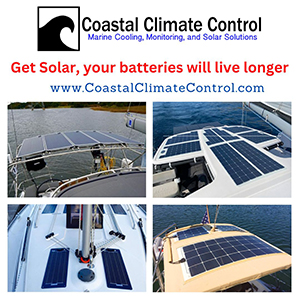
- Media Advertising & Rates
Published by Blue Water Sailing Media, a division of Day Communications, Inc., Middletown, RI
Publisher & Editor: George Day
Blue Water Sailing Media publishes Blue Water Sailing magazine, Multihulls Today and other titles.
Cruising Compass Advertising Sales:
George Day, Newport, RI [email protected] 401-847-7612
- A Guide to 10 Great Blue Water Boats
- Survey of the Week
© 2014 Blue Water Media. All rights reserved. | Admin

Please verify you are a human
Access to this page has been denied because we believe you are using automation tools to browse the website.
This may happen as a result of the following:
- Javascript is disabled or blocked by an extension (ad blockers for example)
- Your browser does not support cookies
Please make sure that Javascript and cookies are enabled on your browser and that you are not blocking them from loading.
Reference ID: 9963396c-ec74-11ee-a79f-f6fdf69668a8
Powered by PerimeterX , Inc.
41 Sailboat Cruising Essentials for Long Trips
In this post I list the items you are unlikely to have if you have never done bluewater or long-term cruising before. There are some essential safety product and also a couple of cool upgrades which will help you be comfortable.
What do you need for extended sailing trips? When going on an extended sailing trip, you need additional navigation and safety equipment, like a life raft, AIS transponder and satellite phone. There are some upgrades you might consider, like self-winding winches and autopilot. For ocean passages, you might need a watermaker and generator.
There's an endless list with upgrades you could do. But if we look at the bigger picture, it's actually just some fundamental changes. If you get these, outfitting your boat for long cruises is easy.
Download the printable checklist here - 100% free
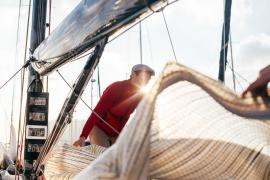
Interactive List of Cruising Gear Essentials
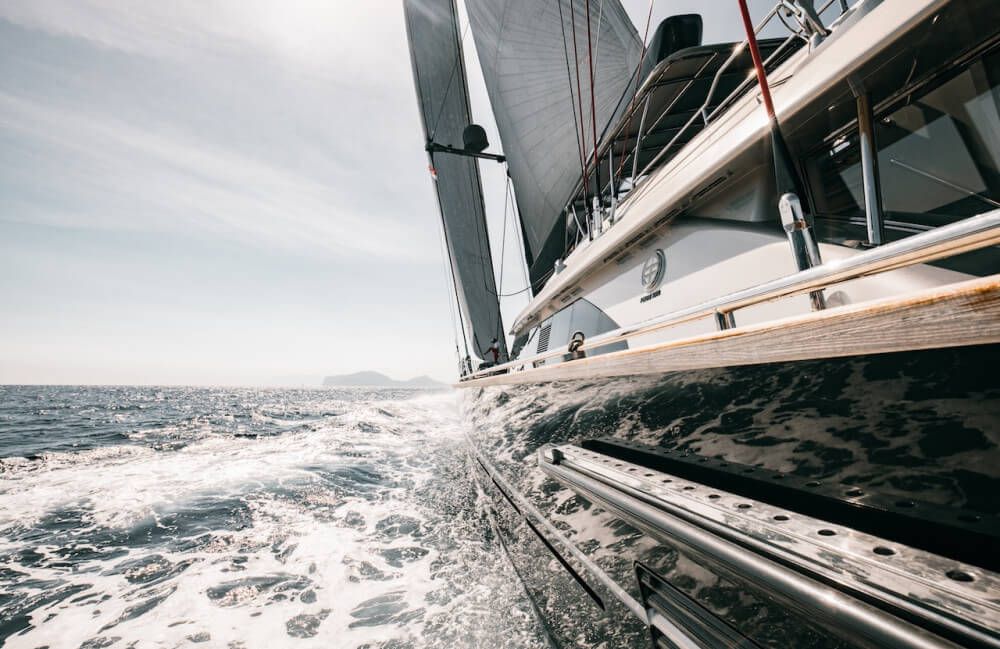
On this page:
The biggest changes to your boat, sailboat essentials to travel and live comfortably, essentials for maintenance, additional safety equipment, things to consider before leaving, related questions.
If you're used to short sailing trips, a couple of things change when going on longer trips. The role your boat plays changes.
First off, it really depends whether you're planning an ocean passage or just a long trip on lakes. If you stay inland, you need less equipment.
For bluewater cruising, the change is the biggest. All of a sudden your boat is a liveaboard boat. On long cruising trips, you need to be self-reliant. You need a source of electricity, more safety gear, and a water maker.
Now that you'll be onboard for longer, these are the things that become more important:
- traveling comfortably - because you travel for longer distances, you might want to upgrade some sailing gear and sailboat parts to improve the sailing experience.
- living well and comfortably - you live on it, so you need to be able to be comfortable and take care of yourself.
- maintenance - you travel in it, so you need to be able to keep on traveling.
- traveling safely - with bluewater cruising, you need some additional safety gear.
So let's dive in. Here's my list with cruising essentials:
1. Watermaker
If you're about to set off on an ocean voyage, you need a watermaker. Watermakers are used to desalinate seawater. They only effectively desalinate about 10% of the water, and they require a lot of pressure (about 800 psi). Watermakers are quite large so you need to build it into one of your cabinets. They're also expensive.
So these are a couple of reasons why getting the right one can make a lot of difference.
You use on average 4-6 gallons of water each day per person. Desalinators filter anywhere from 1-8 gallons of water per hour.
So I'd say the biggest advantage of a watermaker is weight: water weighs a lot and having the option to just suck it out of the ocean instead of carrying around a 750-gallon water tank helps a lot to reduce weight, improving your overall sailing performance and speed.
2. Some Sort of Generator
With long trips, you need to be self-reliant and provide your own electrical power. Most long-term cruisers use some sort of generator to do this. You basically have four options:
- traditional generator
- solar panels
- wind generators
- hydro generators

The traditional generator is still the most commonly used option. But solar is on the rise, and I've seen an increasing amount of wind generators on sailboats. I don't know a lot about them, but I do use solar myself.
A generator is expensive and picking the right one is important - not just for the initial price, but also for the cost of usage. Traditional generators are a bit cheaper initially, and a bit more expensive to use in the long run. Although solar isn't free.
3. Self-Winding Winches
Self-winding winches are winches that hold the line for you while turning the winch. They make life onboard so much easier. They're especially great if you're sailing solo. Some people think they're not worth the investment, and I agree. Replacing the winches is way to expensive for just the extra comfort. But what if I told you, you can upgrade your existing winches at a fraction of the cost ?

I've written an article about how to upgrade your winches to self-winding yourself - read it here (new tab).
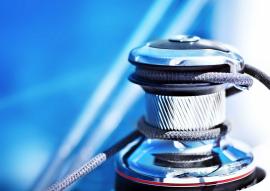
3 Ways to Convert Your Winches to Self-Tailing
4. roller furling sails.
Another major investment that will make cruising life so much more pleasant. Roller furling sails allow you to quickly reef down your sails without much hassle. It does it for you. Great if the weather turns on you.
Agreed, you don't need them. But these might very well be worth the investment. Especially a roller furling jib is worth it. Be aware though that a roller furling mainsail is very expensive - you probably need to replace the mast.
5. Refrigerator
Long trips mean long days, and that means you deserve a cold beer at the end of it. This is one of these household items you simply need for taking care of yourself. You need to keep your food fresh. Especially important with ocean passages, where you could be self-reliant for up to three weeks.

6. Some Sort of Cockpit Canvas
There are multiple options for keeping your head out of the sun - and if you're constantly in the beating sun, you want some cover. You could also get hardtops, but I personally like canvas a lot more. You can change it around that way. Definitely worth the investment.

The Mobmat hangs on the side of the boat. It's a great tool for getting someone out of the water in case of a man overboard. This handy little chair reduces stress in worst case scenarios. And it's also a great hammock for relaxing in the sun.
You can check it out here: Mobmat at ADEC Marine .
8. Autopilot
Autopilot is one of those electronic upgrades you can't really do without if you sail for days on end for longer than 5 hours a day. Especially if you have to cover ground, this is the best way to get by - it allows you to sail at night, while just having someone on watch. But it also helps to reduce the stress of the day a lot - not having to man the helm continuously.

9. Handheld Vacuum
This is one of those items that you only come up with after having lived on your sailboat for some time. It's one of my favorite items on this list (apart from #29 - spoiler, it's a foldable bike) because it makes so much sense. A sailboat can be a pain to clean, but it isn't with a small 12V handheld vacuum cleaner.
I really like this one (click to check current price on Amazon ).

It's a fair price for a powerful vacuum. The best part is that it's able to clean liquids, which is advantageous on a boat. It has served me well. It really increases the quality of my life. I'm not kidding.
10. Outdoor Shower Head
If you like to be clean, this is the best investment you could do for longer trips. Even if you plan on staying in marinas most of the time, this saves you a trip to the showers. You can attach the shower heads to the stern and use them to quickly wash after a salty swim.
11. Water Cans
This one's obvious but it's a shame if you forget to bring them. A couple of 1-gallon water cans will provide you with plenty of freshwater for the day.
12. Headlamp or Flashlight
Having a portable light source is absolutely necessary when you're on your own. I found this out the hard way. One day we found ourselves at the center of a thunderstorm. We were at anchor in the middle of a lake. We felt an urge to move the boat in the dark. Navigating without a light is a pain.
I use this Zebralight Headlamp (click to check current price on Amazon ).
It's way more powerful than any other flashlight I have. It's also practically unbreakable and has rechargeable batteries. I've been a great fan of this head torch for a long time now.
13. Anchors (3)
For open water sailing, you need additional anchors. Ideally, you have your regular anchor and two storm anchors. This is maybe also a good time to invest in an anchor system and roller.
14. Satellite Phone
A boring piece of equipment, but absolutely essential if you are getting off the grid, so to speak. When getting out of range, you want to have a reliable means of communication. The satellite phone never fails and gives you the means to communicate in times of need.
15. Your Car: Picking a Tender
The most popular tenders are rigid bottom inflatables or RIBs.
Having a tender allows you to do two things:
- you can get on shore at beaches while leaving your boat at sea
- you can use anchorages and motor to shore
The first one just looks ridiculously cool. The second is impressively cheap compared to marinas. It's about 5x cheaper to use an anchorage than a marina. Also: there are probably way fewer people there.
So while a RIB can be expensive at first, it can pay for itself. For my trip to the Meds, I'd probably earn back the RIB within a year.
This is currently the most sold dinghy on Amazon . It looks great to me, and it's fairly priced.
16. Picking an Outboard for your Tender
Consider getting an electric outboard, which is way more powerful and durable. It also means you don't have to carry gas. Although the RIB will be heavier because of the batteries.
If you want to get an electric outboard, I'd recommend getting this one from Goplus (link to check current price on Amazon ), which gets you the best bang for your buck.
Also, make sure you have the means to recharge the tender.
17. Radar enhancer
Radar enhancers are super useful. They warn you if the radar of another vessel picks you up. So it's kind of like a passive radar. This means you don't need a radar yourself (which means less energy consumption), but you will know ahead of time that someone is closing in on you.
18. AIS Transponder
More boring electronics. No, actually I love technology.
AIS stands for Automatic Identification System. The transponder goes in your mast head and transmits a signal to other boats. It helps you to avoid collisions. If you think an AIS is overkill, together with the radar enhancer, I'd choose the AIS over the enhancer.
19. Antennas and Range Extenders
These help to extend the range of your navigation and communications equipment, like your chartplotter. They are a must if you plan to do ocean passages, where you'll probably get out of range for most electronics.
20. Handheld GPS
For extended voyages, you need a reliable navigation backup. Most people prefer a handheld GPS. I personally love a reliable compass with some charts. Both have their pros and cons. If you want to be completely safe, carry both, or carry a sextant instead.

I like to bring three navigation tools with me that all three rely on a different input.
I have made a recommendation for a reliable and accurate handheld GPS in my article on chartplotters. Click here to learn which one to get .
If you want to know more about the different marine navigation types , I highly recommend to read my article about it here .
21. For Cold Weather: Hurricane Lamp
It can get quite cold on the water, especially at night. I like to bring a hurricane lamp to warm the cabin a bit. I don't like heaters: I don't need them, don't want to install them, and don't want to fuel them. But a simple hurricane lamp works great for that real cold night.
22. Or Hot Water Bottles
Another great tool - my girlfriend uses these at home as well. And who can blame her, they're so comfortable ... (I don't like to admit that I use them too in secret). Hot water bottles are just simple rubber bottles. You fill them up with hot water and they stay warm for an hour or so. A great and easy way to stay warm.
23. Fishing Tackle
A fishing rod and some tackle don't take a whole lot of space. And it sure is a handy way to get yourself some food when you're in need of it. For me, the math is simple:
- If you don't bring your fishing rod and are in need of food, you are in trouble
- If you do bring your fishing rod, you're floating on top of the largest drive-through on the planet
It's just a great reliable backup to have. And if you're not in crisis, it's still a great way to relax.
No better way to prepare the catch than on a propane BBQ. I like to bring a small and sturdy one. Doesn't use a lot of gas, inexpensive, and doesn't fall over when the boat rocks.
25. Portable Marine Stereo
I have to admit, we are done with the essentials and have arrived at the nice-to-have section. But sailing long distances can be boring for some people, although I love the quiet and piece.
If you do want to break the peace, I recommend you do so using a portable marine stereo, which doesn't merely look good, but also provides killer audio quality for its price.
I have this portable JBL Charge 4 (click to check current price on Amazon ). It's waterproof. The sound quality is plenty good for the price. I was really surprised by the volume and the amount of bass in this speaker. I even find the bass a bit off-balance (too loud) - but that's me.
They also have more high-end models, like the JBL Boombox, which is also waterproof and replaces your high-fi stereo system. It's a bit more expensive but I think JBL delivers on their promise.
26. Outdoor Lighting
Sitting on the deck at night, beneath the stars, is just great. But if you're trying to relax and have a conversation, it's nice to have some ambient light. Luci Lights are perfect for marine purposes. Waterproof, solar powered, and very attractive.
You can check out Luci Lights on Amazon here .
27. Change Lighting to LEDs
A great way to reduce your energy consumption is switching out your cabin lights with LEDs. Your energy needs will halve by a simple switch. LEDs aren't expensive nowadays, and batteries are, so I think this one is definitely worth the (time) investment.
28. Stove Top Coffee Maker
A stove top coffee maker. The Italians call it a 'Moka'. Some use it as a compromise - saying it gets you the best coffee in those circumstances. I disagree. I use my Moka every day. I don't have a coffee machine (and I drink a lot of coffee). I find that a stove top coffee maker gives better coffee than most machines, more consistently, and it's way easier to use and clean.
I just love simple stuff that works great.
29. Foldable Bike
My favorite. Maybe apart from the tender. Earlier I said the tender is sort of your car. But actually, this is. Most sailors operate in a small range within the marina - which makes sense. You travel on water, and then you want to rest a bit.
But I love to ride my bike, and this allows me to get my groceries in town instead of in the marina. It allows us to get to a good restaurant without renting a car (so we can drink a couple of wines as well).
The best part is: you get to the toilet way quicker on this thing.
30. Foul Weather Gear
There's nothing sadder than manning the helm in the pouring rain. Wait, there is: manning the helm in the pouring rain in your kakis. Especially if you will be sailing open seas, foul weather gear is essential.
31. Any Extra Sails You Might Need
If you don't have them already, make sure you carry all the sails you'll need. Re-evaluate your sail plan. I might want a storm jib for ocean use, and a spinnaker for light airs, for example.
To get a complete overview of the different sail types and uses, I highly recommend reading my guide on sail types . In this article, I'll walk you through all the basic sails.
Some essential tools I like to carry to do on-the-fly maintenance.
32. Oil Drainer
Bringing an oil drainer only makes sense for long sailing trips. But it's such a clean and hassle-free way to do an oil change.
For most marine motors, you need to change the oil every 100 hours. However, changing the oil more often is better for the engine. 100 hours may seem like a lot, but it's actually not. If you plan on sailing for more than two weeks, and you find yourself without wind most of the time, there's a good chance you'll use the engine for 100 hours or more.
Oil drainers are inexpensive, and they make an oil change so much quicker and especially less dirty. I always have one onboard.
33. Toolkit for Minor Maintenance
If you need to be self-reliant, you need to be able to do minor repairs on the rigging, sails, and engine.
I like to be self-reliant, regardless of whether I'm doing a small trip or long - this also goes for my car as well.
That's why I always carry a basic toolkit that contains at least:
- 12V cordless drill
- basic hand tools
34. Fuel Cans
Carrying spare fuel is always a great idea for longer trips - even for short ones (I found out with a couple of friends).
How much fuel should you actually carry? It's easy to calculate. Find out how in my article on fuel usage here (opens in new tab).
35. First Aid Kit
I always carry a basic first aid kit. It contains:
- pain killers like aspirin, or something heavier
- large bandage
This helps me to stop bleeding, treat minor injuries, and cuts. For extended voyages, the first aid kit is supplemented with antibiotics and disinfectants.
A quick summary of some additional safety equipment that's required or you might want to consider.
- Fire extinguishers
- Crash Blanket
- Nautical Flags
- Lifesling hoisting tackle - not required but nice to have in heavy weather ocean sailing
If you want to know what safety equipment you need exactly, I've previously written an article about it. Read the article on USCG safety requirements here .
Checks and maintenance
You might want to check the following before leaving
- the ground tackle
- the rigging
- electronic systems
- propellor and engine
You might want to do some maintenance on:
- the hull (anti-foul painting, for example)
- clean the exhaust manifolds
- converting the boat for saltwater use (if necessary)
If you want to know more about how to convert your freshwater boat for saltwater use, you can read my article here .
If you don't already know how to, you might want to consider learning how to maintain the engine and do minor repairs around the boat. I like to know how to:
- change the oil
- flush the engine after saltwater use
- monitor the engine's health (correct RPM)
- repair minor sail damage
- repair the water maker
- check the electricity system for problems
- rewire the electronics
When should boat oil be changed? It's recommended to change the oil of your boat engine at least once a year or after 100 hours of running time. This is the recommendation of manufacturers. Increasing oil changes will extend engine life. Postponing an oil change may cause damage to the engine.
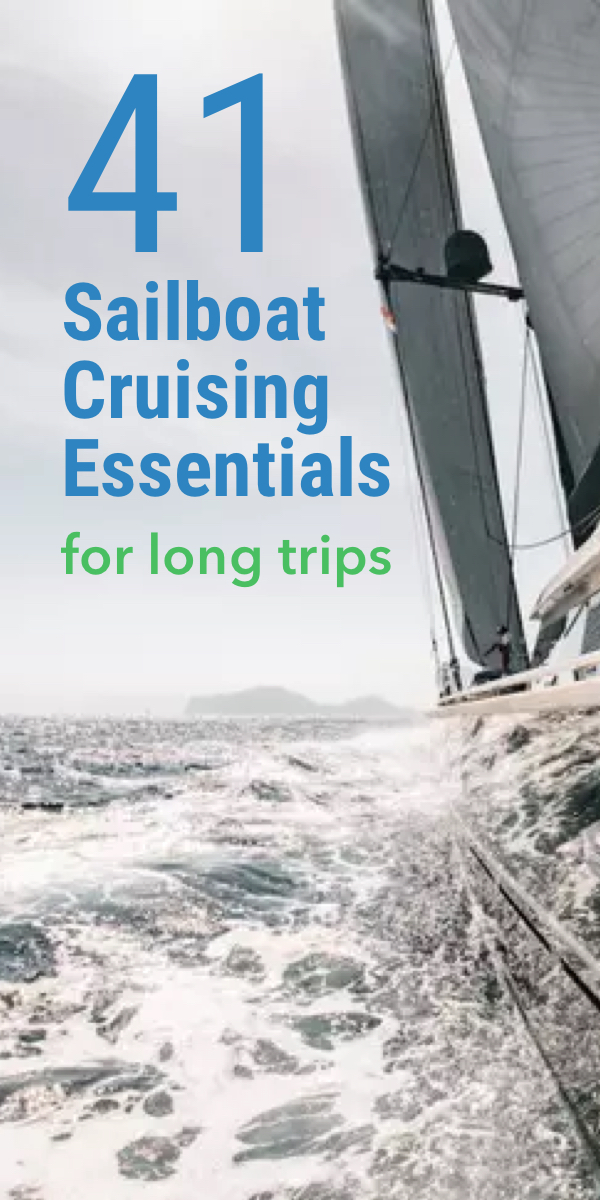
HERSCHEL WEEKS
Terrifically written and very sound advice. I am getting ready for a trip .. I will take a second look at some of my systems. Thanks, Herschel
Filip Larsen
Great artickle (articles). Very usefull.
Daniel Egeland
Very good info. I’m in the planning phase for some long haul sailing that will start in about 3 years. Good list to start off with! Dan
Leave a comment
You may also like, how to convert your freshwater boat for saltwater use.
Some people say that freshwater boats will die in saltwater: a boat that 'has seen salt' won't sell as quickly - myths if you ask me. If you're planning to move …
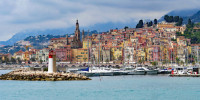
9 Practical Tips & Locations for Sailing the Mediterranean
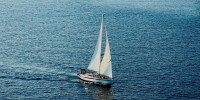
How Long Does it Take to Sail Across the Atlantic? (With Maps)
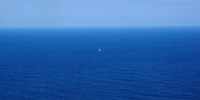
What Is Bluewater Sailing?

How Far Can You Sail In One Day?
Own your first boat within a year on any budget.
A sailboat doesn't have to be expensive if you know what you're doing. If you want to learn how to make your sailing dream reality within a year, leave your email and I'll send you free updates . I don't like spam - I will only send helpful content.
Ready to Own Your First Boat?
Just tell us the best email address to send your tips to:

26 Aug 14 Essential Items For Outfitting Your Boat To Sail The Patagonia Fjords
We learned a lot while cruising in the fjords of Chilean Patagonia, the Beagle Channel, and sailing around Cape Horn. Of course you can watch the sailing videos here to see what life on board at the end of the world is like, but among our biggest lessons was learning about what to bring, and how to prepare our boat. There aren’t a lot of cruising guides online for Patagonia, and we intend to detail our trip in the blog, to follow along with the videos. Let’s start with how to prepare your boat.
Boat Heater
We survived with 3 heat sources, but we could have had some better solutions had we intended to stay longer at high latitudes. We could have made it with no heat, especially in the Austral summer, but it would not have been pleasure cruising.
Our primary heat source was a cheap Chinese forced air diesel truck heater . After an installation learning curve, this heater performed flawlessly for us throughout our trip. The 5000 model was enough to keep our boat warm enough inside but was underpowered in below-freezing temps and icy waters.
We also carried two small plug-in electric heaters (one 110v and one 220v), which we used on rare occasions at a dock. Ushuaia, Puerto Williams, Puerto Aguirre, and Puerto Montt, are the only places where plugging in is available, and prepare for unstable power supplies and long cords.
A note on wood heaters. It is possible to use a wood stove. We know of at least one sailboat in this area that does this. This is what heats all of the old fishing boats down south. There is a special type of wood in the fjords that burns when damp, but you will need to be able to identify it, and all the fishermen carry chainsaws . It does add an element of risk of a blowdown fire, which is the #1 reason for house fires in Southern Chile. As romantic as it sounds, we would stick with diesel.
Sleeping Bags
We consider a 0-degree sleeping bag for each crew member a must. We have four on board, two as spares. They are small and light to carry and make for a welcome cocoon on cold nights when it is blowing 40 and hailing outside. We also consider them important for safety. In case of injury, hypothermia, or heater failure.
There are a variety of options on the market to suit all types of different preferences and budgets. Ours are mummy type bags, but keep in mind that though warmer, they do restrict the movement of your feet just a little. Depending on how extreme your cruising will be, you may be able to compromise a bit in this area. No doubt though, a 0 degree sleeping bag of some type on board your boat in this weather is a must!
You won’t find this in any cruising guide, but we loved making coffee, tea, and ramen noodles without Jet Boil camping stove while sailing in Patagonia.
The gas bottles can be found in Ushuaia, Puerto Williams, and Puerto Montt. It saves on our main stove propane supply, and lugging the larger propane (gas or gaz) for refills.
Most of all it helped keep condensation at bay. We made our coffee in the companionway with the hatch open, allowing the steam to escape the boat out of the open hatch.
We aren’t brand loyal here, consider the term Yeti used by us like Xerox for copy machines. We recommend some stainless steel vacuum double-layer mugs with sipping lids. We use these Yeti Rambler Tumbler / Coffee Mugs pretty much every day.
Not only do they stop spills on the boat, but more importantly, they keep the steam in the cups. This keeps it off of your ceiling and from raining back down on you from your through deck fasteners.
They work well for hot drinks, and they are also a stable and spill-free platform to enjoy your Chilean Carmenere red wine on a gusty evening at anchor.
Since we touched on the topic of condensation, you are beginning to see how much of a problem it is. Our boat is not insulated (we would highly recommend an insulated boat, or installing boat insulation , if intending to spend many seasons down south) but we did take some steps to control heat loss and minimize condensation.
We used foam mats which we cut to fit our windows and hatches. We also covered two of our windows with foam and shrink-wrap tape. This was a cheap and temporary solution that worked well for us.
We would consider more foam mats inserted above our headliners and against our outer hull, especially in cabinets with little ventilation or clothing.
Most long-term boats had added a second lexan layer to the interior of their hatches and windows, making them essentially double-pane windows. For a one-time pass-through, we would say this is nice but not required. If staying for a while, it would be a good idea to do. Keep in mind though, it is important to be able to open your hatches and ports to ventilate and dry out the boat on the rare nice sunny days.
Ventilation
As one can imagine, a heater, large temperature fluctuations, condensation, and dampness are a nasty combination that can ruin the wood interior of a boat and cause mold growth.
As tempting as it is to load the boat with provisions and spare parts, don’t pack all of your cabinets so full there is no airflow. Make sure there is room for the boat to breathe.
We would encourage vents in damp lockers and bathrooms. The marine solar vents work well, but get the sealable type for extreme conditions.
Dorades are also wonderful. Our boat has 4 huge dorade vents which give the cabin excellent airflow. Don’t forget to vent your anchor locker and aft Lazerettes. This can be done by just opening the hatches on good days.
Our fans we used all the time in the Caribbean, we thought would have little use in the cold high latitude sailing climates. They came in handy to move air around the boat.
If you can’t tell by now, condensation is really the worst enemy of your boat in these parts.
This may be the first thing most picture when thinking of sailing in this area, and most cruising guides cover this topic in more depth. We originally arrived hoping to buy them in South America….forget about it! Just buy your shore ties before you leave.
Mooring line reels were awesome (we only had one). We suggest buying two or having some fabricated.
Our two primary shorelines were each 100 meters long. These were 3/4 inch 3-strand polypropylene floating ropes . This worked well.
Our secondary lines (we used these for the bow) were 1/2 inch 3 strand polypropylene, each 110 meters long.
This setup worked well and seemed a good compromise of weight and strength for our boat. There were only two anchorages where we wished for more shore ties (6 ties in total) and in those instances we strung together some old Jib sheets and dock lines.
Along with our shorelines we also had 2 cables, looped at each end, for wrapping around rocks, which we used a few times and came in handy. These are easy to source locally and can serve a secondary purpose of a dinghy lock when traveling in more “civilized” areas.
Small Sails & Reefing
We were very glad to have our staysail set on an inner forestay. it was used often here. The third reef in the mainsail is also a must-have in Patagonia. We suggest addressing these items before you leave your home port, as sailmakers are few and far between in these parts.
We also had a 4th reef in our mainsail and carry a storm Jib.
We haven’t had to use each (we used the 4th reef once to test it and set the storm jib to practice and learn), as we are careful with weather routing, but we are happy to have these at the ready. Think, if we do our weather routing jobs correctly, we should never have to use these items, they are an insurance policy.
Our storm jib was made by Andy @ Evolution Sails Chicago, give him a ring and tell him the crew at Sweet Ruca sent you. He has extensive experience discussing our specific needs for high latitude sailing aboard a performance cruising sailboat. Both our 4th reef and our storm jib were sized specifically for our boat, our existing sail plan, and the conditions we would likely have to use them in (real storm conditions).
Keep in mind most “storm” sails on the mass market are normally designed for racing minimum sizes, or for wind conditions the majority of cruisers will see. In the cold air and big storms of the deep south we found things a bit different, we put together a well balanced and usable setup to allow the boat to sail well off a lee shore in sustained winds above 45 knots. https://www.evolutionsails.com/sail-lofts/usa/chicago/
We only used our primary anchor here, and never used a stern anchor in the fjords. We do carry a second spare anchor, just in case. There have been reports of lost anchors due to deep snags in some anchorages.
We chose an oversized Rocna 33kg anchor for our boat (the maximum size recommended by Rocna on their website, which Peter Smith personally confirmed was adequate when he saw it on the bow of our boat). We think any similar modern anchor will fit the bill as well.
Our primary anchor also has 200 feet of 10mm G4 chain, and 200 feet of nylon 5/8” 3 strand rode spliced on the tail. We are prepared to anchor in up to 200 feet of water in an emergency. Twice we anchored out in the big ship anchorages in 90-100 feet of water, and we were very glad to have this ability when needed.
Our secondary anchor is an Aluminium Fortress FX-37 anchor with 50 feet of 10mm chain and 150 feet of 5/8” nylon rode.
Lastly, get yourself a sickle or tree pruning saw to cut away any kelp that comes up on your anchor. We aren’t joking! We had so much kelp on our anchor once, our big Rocna floated in the patch of weeds! We used a small folding saw, locked at a 90 degree angle, and lashed to an extendable boat brush handle, this worked great. We also had a machete on board, which also comes in handy if you need to get through the thick brush on shore.
If southbound fuel is less of a concern, but if northbound, against the prevailing wind and current, be prepared to carry more fuel! We bought our extra cans in Uruguay and Puerto Williams, but if buying in South America be prepared for slim pickings, and don’t expect to see a Budget Marine or West Marine! Parts for yachts are hard to find. You can find some cheaper options for jerry cans than those marketed for boats, such as those containers used for bulk oil sales or industrial chemical shipments.
We wished for more built-in fuel capacity (we have 90 gallons of tankage, but would have loved another 30 built-in). Another option we have seen used is fuel bags , dedicated expandable tanks which can be strapped down on deck for extending the yachts range. We opted for standard 20 Liter (5 Gallon) jerry cans, 19 of them to be exact on board our boat! We purchased O rings for our Jerry cans to seal them better and stored them below why sailing (make sure to secure them). We aren’t a fan of cans on the deck while sailing for multiple reasons: better sailing performance, trip hazards, lines, stability.
You will need Jerry cans to shuttle fuel as fuel docks for yachts are difficult here. If you are coming from the USA, make sure not to get the EPA nozzles, as they are a real pain to fill with large boat nozzles (think buying your fuel from the same hoses as huge fishing boats) because of the little plastic piece inside. Once out of the USA, no one cares what color your jugs are.
Navigation & Weather
With the advent of Starlink , this game has changed. It worked for us throughout the fjords, and we were perhaps the first sailing yacht to go through the area with it. We did find that many of the local fisherman were using it as well.
Access to weather information is the key to a safe and fun trip here. Predictwind offshore app worked well and also allowed us to download satellite AIS which was handy.

C-Map charts were junk here, except for in the main shipping channels of the Magellan Straight and Puerto Montt.
We used mostly the iSailor app which was recommended to us by multiple Chilean Armada captains and by the Antarctic charter boat crews. We supplemented this with Navionics and Sat2Chart in OpenCPN . We didn’t touch our paper charts with the exception of Cape Horn, and that was just for nostalgic purposes.
Patagonia Cruising Guides
There is only one you need, the Bible. The Patagonia & Tierra Del Fuego Nautical Guide . Some of the information is a bit dated at this point, but for the most part, all of the anchorage information and depths are pretty spot on (we always used caution and worked slowly in uncharted waters using our depth sounder and suggest you do the same, there are keel crushing sized rocks down there).
The tide and current information was OK, but we never quite found an extremely accurate source of data for this, as even the Navy here acknowledges that the tides running between all of the small islands are too complex to forecast. The data in the two guides though gives you a good overview and we never had any problems timing the tides with a careful eye and a wrist watch.
Any others we consider supplements, many carried the Imray and the RCC guide , which have some details on a few anchorages not covered in the Bible.
Spare Parts
Getting parts in South America is a pain in the bottom! Expect a minimum of 2-3 weeks to receive anything offered online (even if you next-day air it) and sometimes up to 2 months. Just throw out any ideas of ordering what you need and getting it in a few days. Bring what you need from your home port or somewhere like St. Maarten.
Here is a short list of maintenance items to bring:
Water Pumps Water Filters Fuel Pump Fuel Filters Oil Filters Engine Fluids (oil, trans, coolant) Alternator Exhaust Elbow Engine Belts Heater Repair Parts Head Repair Parts Hoses Wire Wire Connectors Fuses Rope Clutch Spares Winch Rebuild Kit Furler Repair Items Mast Cars or Bearings Sail Repair Kit Dinghy Repair Kit Epoxy (We like GFlex in the mixing tube) Snatch Blocks
We didn’t use most of our spares. We did go through an engine impeller, a set of fuel filters (primary and secondary), and two oil changes (oil and filters).
We would possibly consider adding windlass spares to this list, especially if yours has some miles on it already. We suggest going to Amazon.com and creating a cart or a wishlist, searching for your needed spares, and adding them to your cart or list. Save it for later and you will always have it at hand to quickly go back and order from. This has saved us quite some time over the years.
Make sure your safety gear is up to snuff. One should have all the offshore gear already on board if venturing to these parts.
The only special item we added for safety while sailing here was immersion suits (some call them Gumby suits). This is true cold-water sailing, and help could be days away in the remote areas of the canals. We didn’t have to use them, but we were happy to have them on board.
As with sailing in any new place, there is always a learning curve. The bottom line is to be prepared. Don’t expect help from others, but do have the ability to help those in need. That is the way we travel and the mantra has done well for us. Safe and fun sailing to all!
Affiliate Links: Links to products in this article may contain affiliate sales links. We do this to pad our cruising kitty so that we can offer this information at no charge. By clicking the links and buying items from Amazon , we earn a small commission. In our opinion, Jeff Bezos’ yacht is plenty big, and we aren’t fans of sending more customers that way, especially over small businesses, but this way we can take a little from his boat fund and put it toward our grocery, diesel, boat maintenance, and web hosting costs we we can keep creating inspiring content for you!
John Stanham
Excellent advice. I have been following sailors like you for a few years at both ends in South America and the Inside Passage.
Having seen how brutal and shifty weather conditions are in the Southern South, I knew I was in for some serious learning when I saw you navigating East to West and during the Winter. Appreciate your sharing your wisdom. Stay safe.
Hi John, We are glad to hear you are enjoying the adventure.
Boat Gear & Outfitting
Outfitting a boat to cruise – or circumnavigate – is really hard work. We finished our circumnavigation in 2020, and have learned what works on a cruising boat – and what doesn’t.
The number of items you can order for your boat off Amazon is amazing. Many of the best items on our boat are ordered from Amazon.
Boat Gear: Fun & Active Stuff
- Snorkeling Off Your Cruising Boat
- Exercising While Cruising
- iPaddleboards v iKayaks
- Fishing Gear for Cruisers
- Set Up and Review of Sea Eagle Inflatable Kayak
- Video Gear & Cameras for Sailing Videos
- A Year with our Drift Paddleboards
Boat Gear: Galley Equipment
- Magma Pots & Pans
- Reducing Disposable Plastics in the Galley
- What’s In My Galley
Boat Gear: Miscellaneous
- Flex-o-fold Folding Propellers
- Using the Marie Kondo Method to Tidy Our Boat
- Cruise RO Watermaker Review
- Tools for Cruising Boats
- Communications While Cruising
- Marriage Saver Headsets
- Five of our Favorite Things
- Offshore Medical Kit Contents
- Books for Cruisers
- Foul Weather Gear
- Our Mantus Anchor Unboxing
- Man Overboard
- Book Review: Care & Feeding of Sailing Crew
- Our First Christmas Gifts as Cruisers
Boat Outfitting
Our boat outfitting was a 3-step process. We started in La Rochelle, where we picked up our new Fountaine Pajot Helia 44. We did the barebones work needed to make us comfortable bringing her across the Atlantic double-handed, working with Uchimata. When we arrived in Miami, our broker completed the commissioning and we did some projects there. Then, we sailed around to Palmetto, Florida, where we spent three months getting the final big projects done.
- Selecting Factory Options
- Electrical Systems for Cruising Boats
- Outfitting a Cruising Catamaran
- Palmetto Projects: Enclosure and Hardtop
- Palmetto Projects: Solar
- Dropping the Temperature
- Anchor Chain Upgrade
- Custom Silverware Organizer
- Choosing our Trampoline
- Hydrogenerators
- November 2015: BVIs – at Nanny Cay
- February 2016: Grenada Marine
- December 2016: Whangarei, New Zealand at Norsand Marine
- June 2017: Vava’u, Tonga
- January – March 2017: The Boat Works, Australia
- January 2019: PSS, Thailand
- February 2019: G&T Boat Yard
Boat Projects
- Running Lines Through the Mast
- Swapping and Cleaning a Transducer
- Converting Heads to Freshwater
- Swapping a Windlass Gypsy
- Re-bedding Deck Hatches
- Resizing Battens
- A Perfectly Executed Boat Project
- DIY Bottom Job
- Repairing our Quick Chain Counter Sensor
- DIY Dyneema Lifelines
- Replacing our AGM Batteries with Lithium-Ion
- Three-Year Maintenance
Offshore Medical Care
- Medical Books to Keep On Board
- Offshore Emergency Medicine Course
- Vaccines for Cruisers
Latest Posts
- Best Modern Sailing & Cruising Memoirs
- Our Electrical Refit and New Catamaran Solar Arch
- Flexofold Folding Props Review

Home » Blog » Travel » Small sailboat, small budget, BIG adventure
Small sailboat, small budget, BIG adventure
By Author Guest Post
Posted on Last updated: December 4, 2021
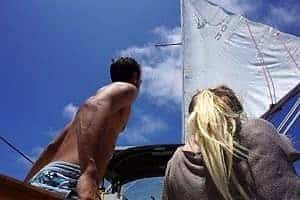
“I’m a twenty-year-old sailor, but I would identify as an old salt.” says Cooper VonAchen. Cooper is preparing to sail from California to Mexico and the South Pacific, but he’s gone about it differently: namely without a big boat, fancy electronics, complicated systems, or even a marine head! “I preach simplicity and truly voyaging under sail… not your diesel.” Today, he shares how he equipped his small sailboat with old technology so he could afford to go cruising while he’s young.
The ultimate “Go small, go simple, go now” cruising philosophy
People tell me there are all kinds of things I “must-have” in order to go cruising: an electronic chart plotter, autopilot, etc.… But when I hear people launching into this ever-growing list of items, I find myself thinking, “That would be nice, but I want to go now.”
Being only twenty years old, I haven’t had a lot of time to work and save for the ideal cruising machine, “Go small!” people told me. However, I quickly discovered that “small” doesn’t always mean affordable. For example, a Dana 24 is an amazing small cruising sailboat, but you would be hard pressed to find one for under 30K. A 28 ft. Bristol Channel cutter can easily cost upwards of 100K dollars! How about one of the handful of small bluewater boats that fall into the category of “Go small, go simple, go now,” but cost an outstanding amount of money? How does someone young and broke afford one of these “small” sailboats? You can’t.
My solution was to go small in size and price. That may sound like complete idiocy; everyone would love to find a sweet little boat and pay next to nothing for it. I bought my Canadian Sailcraft 27, a rugged, wide-beamed, seaworthy design (and the cutest boat you’ll ever see in an anchorage or marina) for 8,000 dollars. I would say that is next to nothing for a small cruising sailboat. All of her standing rigging is brand new, she has a lightly used Yanmar diesel, there isn’t any delamination or water in the decks, and she came with a full set of sails, including a brand-new mainsail. You can’t ask for much more than that for $8,000. But this took constant searching and looking for a boat that was in my price range and wasn’t complete junk.
Looking for a cheap sailboat? Check-out How to find cheap boats for sale on Craigslist and the best places to look for used boats.
This wasn’t a one-off however. There are numerous small sailboats out there that aren’t considered to be bluewater cruisers that can easily get the job done. The Newport 30 MKII is a great small sailboat that has made several pacific crossings to and from California and Hawaii. If it can do that, then why not take it farther. You would be surprised what some of these “coastal cruising” boats are capable of. People have taken homemade rafts across the Pacific for crying out loud. You can take a small sailboat with stainless rigging and a fiberglass hull and do the same thing, with great comfort and safety.
Now, the second part of the famous Pardey saying is “go simple.” Simplicity is key my friends. Simple works and doesn’t break easily. Simple will allow you to get to a destination and enjoy it rather than “fixing your yacht in paradise”. Go simple on the electronics. Do you really need a wind indicator, a knot meter, and electronic chart plotter, a big screen GPS, an expensive and power-hungry autopilot? No, you don’t. You actually don’t need any of these things to enjoy cruising. What you do need is good sails, a sound hull, a handheld GPS, plenty of water and food storage, a good anchor with plenty of chain, paper charts, a reliable dinghy, and a means of self-steering. A simple list. Many go small, but few go simple.
Editor’s note: Lin and Larry Pardey have written dozens of books on cruising including this classic “Cost Conscious Cruiser” with tons of great cost-saving tips.
Think about trying to fix your marine head in an isolated island chain. How do you fix the absolutely disgusting problem of a malfunctioning head and blocked holding tank system? Believe me, I know how bad this can be… and you don’t want to know. I’m not saying rip out your head and holding tank and make a composting bucket head like I did, but just think about other examples. What if your water pump breaks in your galley and you can’t get water out of the sink without siphoning it out of the holding tank? Why not just install manual pumps in your galley and head to eliminate the issue from ever arising? I know this can be a pain, pumping away just to get water out of your faucet, but time not wasted on fixing your boat is time spent enjoying the places you worked so hard to be.
Now I don’t need to go into detail on exactly how I outfitted my small cruising sailboat, less electrical more manual systems, because you can just apply this ideology into your own outfitting process. In any place where you can eliminate complexity and cost, do so.
Self-steering is a tricky subject. It is very hard not to spend large amounts of money on self-steering gear. Whether it be an electric autopilot, or a wind vane, you are going to spend money on self-steering. Unless you are as crazy as me and just can’t wait until you have the funds to purchase such a device. I went with the sheet-to-tiller method of self-steering. Now you experienced Yachtsman are going to turn your nose up at such an outrageous choice of self-steering gear as there are only a handful of people crazy enough to use this method to steer their boat across oceans. If you do not know what sheet to tiller is, you effectively use the tension in your sails to apply negative feedback into your boat, more or less keeping it on course without anyone touching the helm. This method is wonderful for one reason alone, it cost roughly 100 dollars for a system that can keep your boat on course. Now there are many downsides to such a decision. First, this system only works with a tiller, not a wheel. Second, any time that the power or direction of the wind changes, you are adjusting the self-steering gear. So effectively you have to adjust your boat every hour or so to keep it on course. That means if you are single handed, you only really have an hour at a time to sleep at night during a crossing or an overnight sail. t forces you to sail your boat more, which if you enjoy sailing, is not such a bad thing.
Many cruisers would also like to talk about dinghy choice, hard or inflatable? Outboard or rowing? But what do you think I chose? I chose a hard dinghy that can row well. Cheap Outboard motors break down constantly and good luck finding parts in remote atolls. Oars don’t stop working. A hard dinghy can take a beating and continue to float and get you and your crew to shore. Inflatables spring leaks and need to be patched all the time. UV radiation can deteriorate the fabric of inflatables causing you to replace your tender every couple of years. That does not fit into my philosophy of simplicity.
Editor’s note: We used a rigid Costco Kayak as our tender for our entire 8 month Pacific Crossing. Inexpensive and indestructible!
I think you can extrapolate the rest my outfitting process just from my self-steering choice alone… minimal. I only chose exactly what I will need, not what I want, or what will make life as easy as possible, but what will give me the most time to enjoy cruising. Because if you are working on your boat or working to pay for it in the first place, you will never truly enjoy what the cruising life has to offer because all of your time is being eaten away by what many would consider vital necessities.
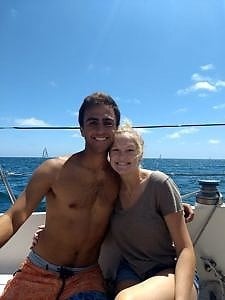
Follow Cooper’s story on his blog https:// theadventuresofcaptaincooper. wordpress.com and Instagram @cooper_vonachen
Terms and Conditions - Privacy Policy
Outfitting a sailboat for long-term cruising can seem like an overwhelming task. With so many things to consider, it can be difficult to know where to start. If you’re serious about cruising and want peace of mind in knowing you have all the most important things onboard. Here are 10 essential items for outfitting your sailboat for long-term cruising that no sailor should be without.
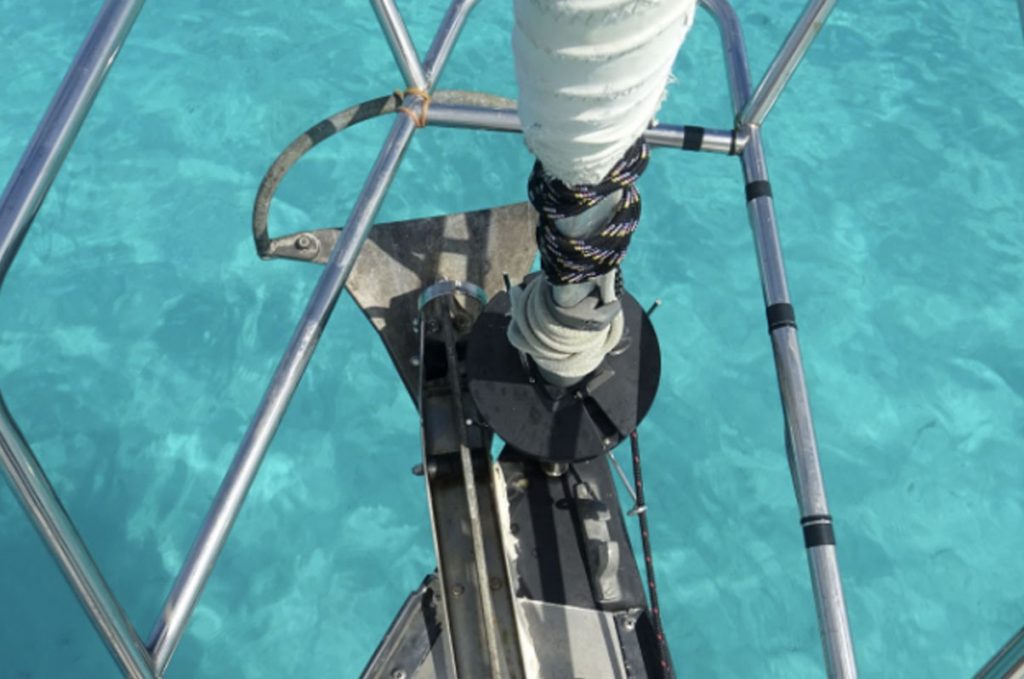
1. Anchor
The first and most important item on the list is a quality anchor and chain. A good anchor is essential for sleeping well at anchor, and it’s important that it is strong enough to hold in a variety of conditions. I recommend going with an anchor that resets itself easily with a wind shift like a Mantus or Rocna. A quality chain with the right amount of scope will also help to ensure that your anchor stays firmly in place. When possible, it’s best to use a ratio of 7:1 scope, which means for every foot of water depth, you should have 7 feet of chain out. This will help to ensure that your anchor sets properly and won’t drag in changing conditions.
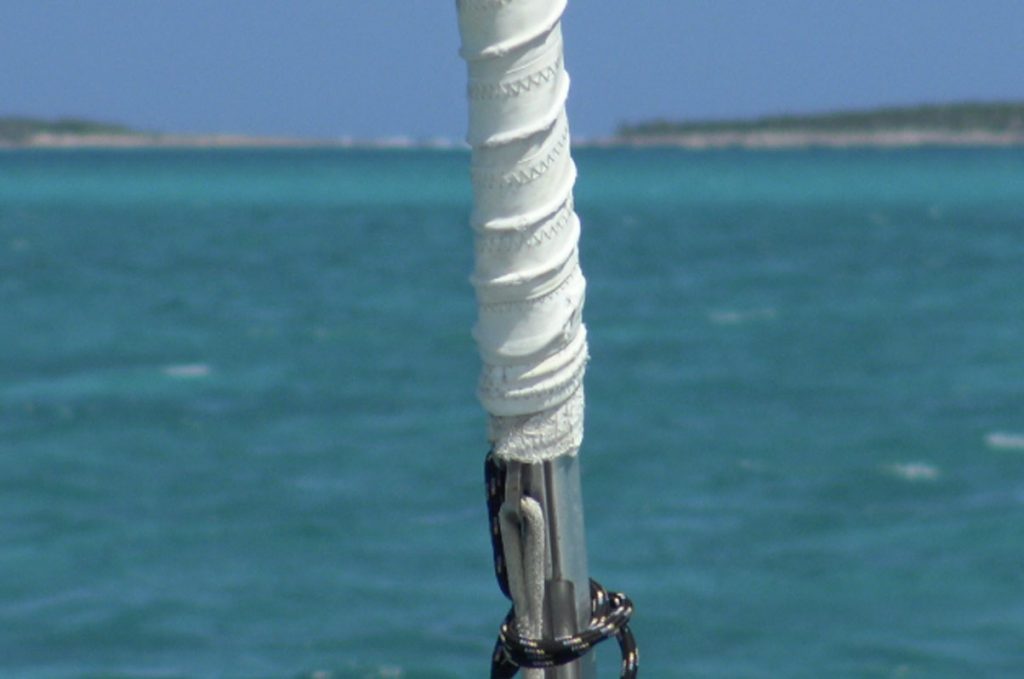
2. Furling Headsail
Next, a furling headsail is a must for many when cruising long term. This versatile sail that can be unfurled and furled from within the cockpit, making it easier to adjust sail trim in changing wind conditions. This is especially useful when sailing short-handed in more challenging conditions.

3. Watermaker
A watermaker is also an important item for comfortable long-term cruising. A watermaker will enable you to turn salt water into fresh water, which can be used for bathing, washing dishes, and drinking. This can also be a lifesaver during long passages when you’re running low on fresh water. It’s a great alternative to lugging your water by dingy but for longer times away from civilization the watermaker is absolutely needed. We do not have one on board currently but it is high on our list of upgrades to get.

4. Dinghy
Having a quality dinghy and reliable outboard motor is just as important as outfitting your sailboat. A dinghy and outboard are useful for getting to and from shore, as well as for exploring shallow waters that your boat may not be able to access. It replaces your car at home and we all know just how important a vehicle can be with no access to public transit. Groceries, water (without a watermaker), fuel, adventure, are just a few examples of things we use a dinghy on a daily basis. It can even be used to propel your vessel during an engine failure, surprisingly well i might add.
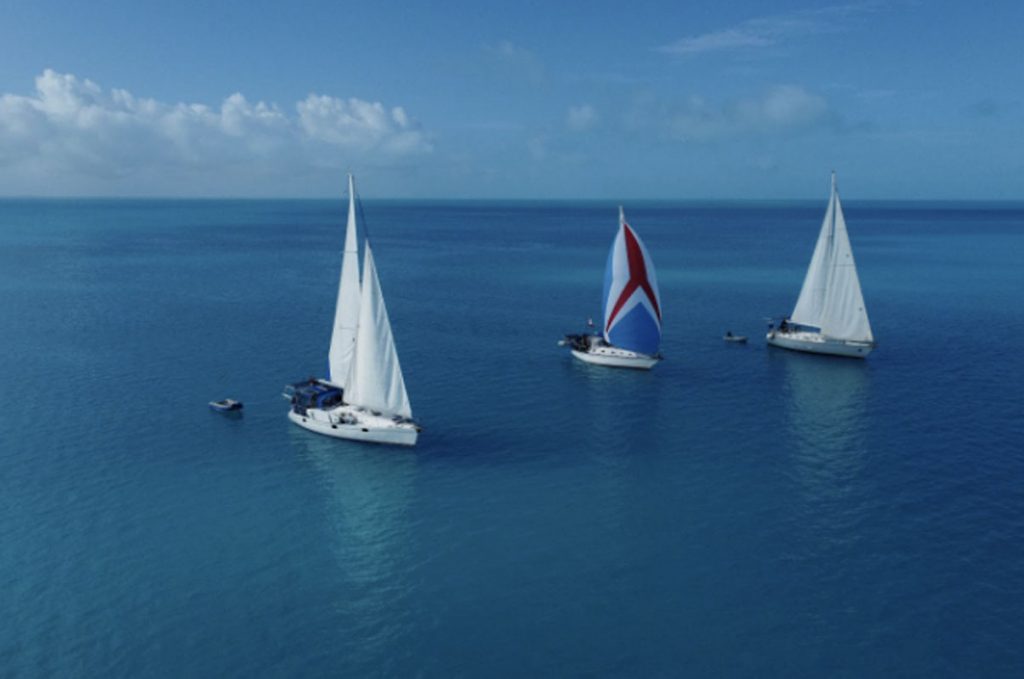
5. Sails
Sails and a sail repair kit are also essential for outfitting your sailboat for long-term cruising. Sails are needed for powering your boat in different conditions, and a sail repair kit is useful for making quick repairs at sea. It’s important to have a variety of sails onboard, from storm sails to light air sails, and a selection of sail repair materials such as sail tape, webbing, and thread. Additionally, it’s important to understand the basics of sail repair and maintenance so that you can make the necessary repairs when needed. Having the right sails and a sail repair kit onboard will help you make the most of your time out on the water.
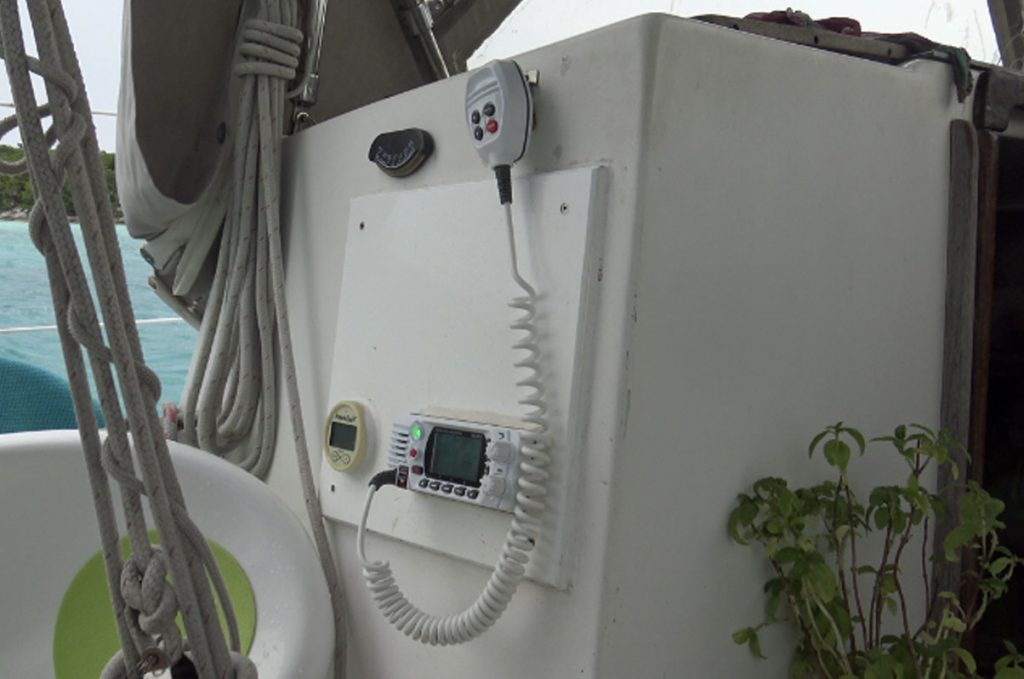

6. Navigation Equipment
Navigation and communication equipment are also essential for outfitting your sailboat for long-term cruising. Navigation equipment is for planning and executing passages, while communication equipment is needed for staying in contact with other vessels, marinas, and land-based services. A tablet with your favourite charting app paired with a VHF radio is how we accomplish this.
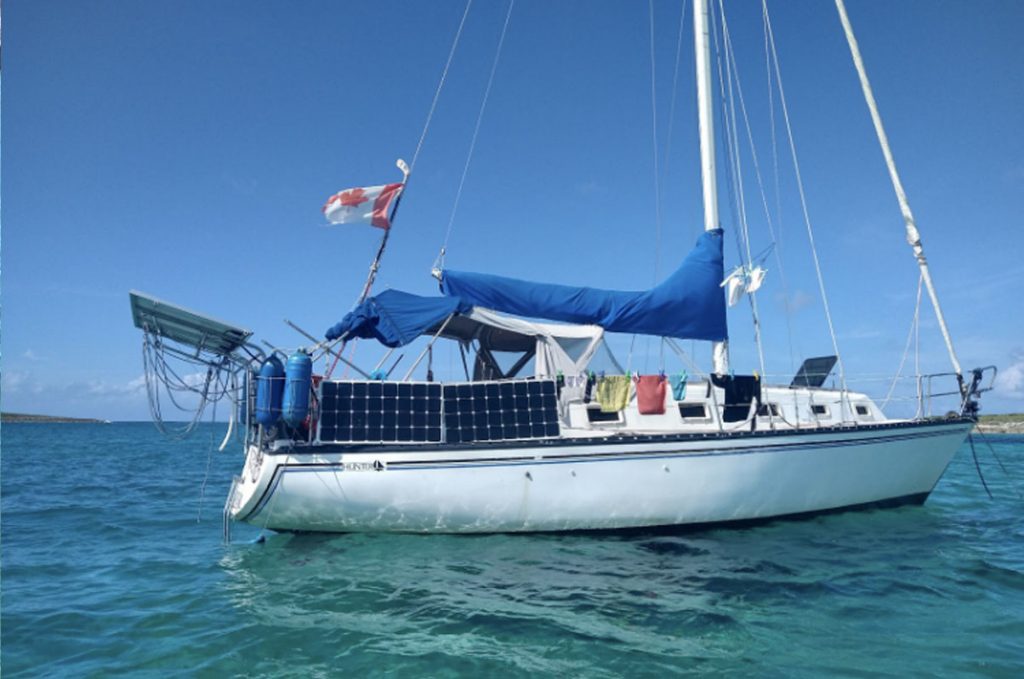
7. Solar Panels / Wind Generator
Solar panels and/or a wind generator are also essential for outfitting your sailboat for long-term cruising. These can be used to generate power for running electrical equipment and charging batteries, removing the need to go to an expensive dock to plug into shore power. Additionally, solar panels and wind generators can be useful for generating enough power to run a fridge and other appliances, allowing you to be more self-sufficient and reduce your reliance on external sources of power. When choosing solar panels and/or a wind generator, it’s important to consider the type and amount of power that you need, as well as the size of the panels or generator that will fit on board your boat.

8. Spare Parts
Spare parts and tools for maintenance are essential for keeping your sailboat going during a long term cruise . Having spare parts and tools onboard can be a lifesaver if you find yourself in need of a repair while at sea. It’s important to have a variety of spare parts and maintenance tools, from basic hand tools to specialised equipment for more complex repairs. Additionally, it’s important to understand the basics of sailboat maintenance such as inspecting the rigging, servicing the engine, or just putting down a fresh coat of paint. Having a good understanding of how to maintain your vessel can help you make the most of your time at sea.
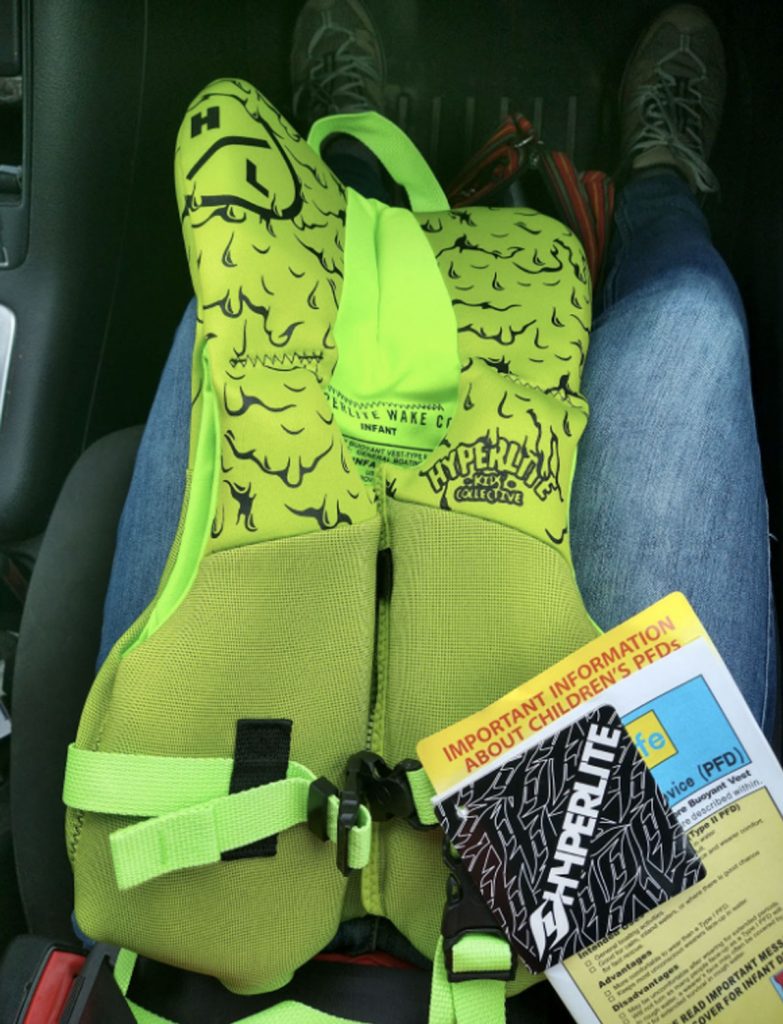
9. Emergency Supplies
Additionally, emergency supplies such as life jackets, flares, a first aid kit, and a fire extinguisher are essential for ensuring your safety and security while underway. Depending on the size of your vessel and home port, you will require different amounts of supplies. A well-stocked first aid kit is especially important for providing basic medical care when needed, these supplies may just save your life in an emergency.

10. Mask and Snorkel
Finally, a mask and snorkel can be invaluable for a sailor outfitting their sailboat for long-term cruising. This one almost didn’t make it on the list but considering how useful it is I would never be without one. A mask and snorkel can be used to un-foul an anchor or chain, clear a jammed thru-hull, clean the hull of your boat, clear a tangled prop, or even catch yourself some dinner! A mask and snorkel can also be used for recreational activities such as exploring shallow waters, snorkelling, and experiencing the beautiful world below the surface. Additionally, a mask and snorkel can be a great way to cool off and relax while at anchor.
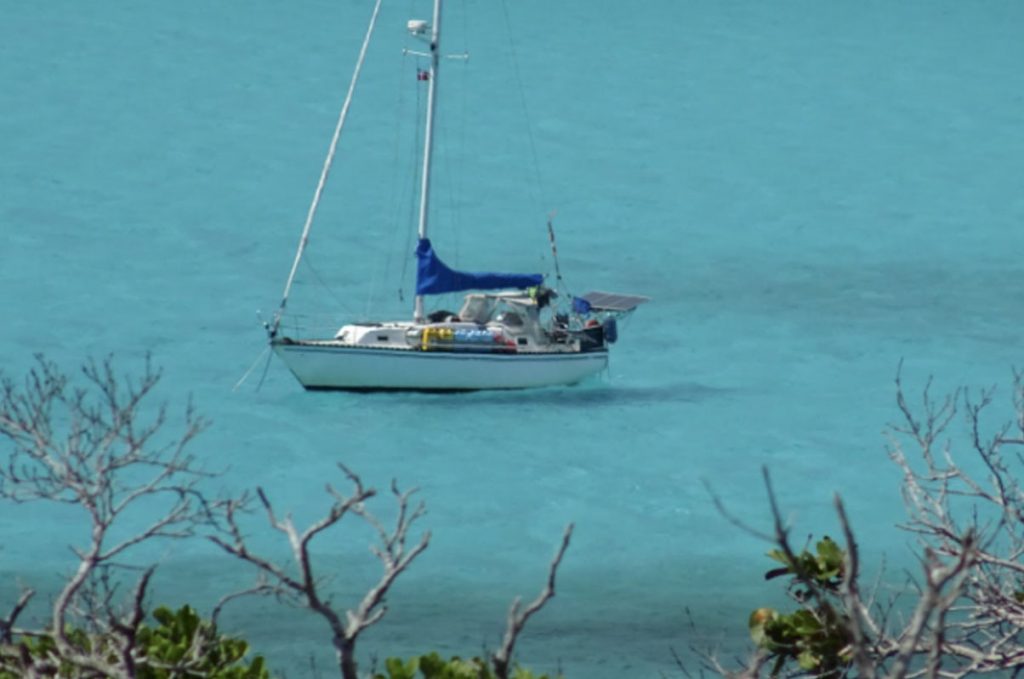
Outfitting your sailboat for long-term cruising can be a daunting task, but having the right items onboard can make a huge difference in your comfort and safety at sea. Quality anchor and chain, furling headsail, watermaker, dinghy and outboard motor, sails and sail repair kit, navigation and communication equipment, solar panels and/or wind generator, spare parts and tools for maintenance, and a first aid kit are all essential items for outfitting your sailboat for long-term cruising. By having these items onboard and understanding the basics of sailboat maintenance, you can ensure that your vessel is well-prepared for any situation that may arise and make the most of your time out on the water.
Cory Bertrand
Cory and Alex share their adventure with weekly videos on their YouTube channel “ Wildly Intrepid Sailing ” and share stories on their website www.wildlyintrepid.com . Their dream is to travel the world and to live without any regrets.
Sign up for our Newsletter
Enter your details and receive exclusive news, deals and more!
- The Great Loop
- Anchoring/Ground Tackle/Dock
- Cruising Gear/Electronics
- Power/AMPS/Alternative Energy
- Leave the Boat
- On the Hard or In the Water
- Hurricane Preparedness
- Return to the Boat
- Problem Solving
- Preventative
- Sails & Canvas
- What Works/What Doesn’t
- Anchoring/Ground Tackle
- Foreign Check In/Check Out
- Galley/Provisioning/Life Aboard
- Safe Cruising/Local Knowledge
- Seamanship/Sailing the Boat
- Throw Off the Dock Lines!
- What’s It Cost … How Much?
- Bahamas and Exumas
- Providencia, San Andres
- Florida Keys
- Mexico/Yucatan Coast
- Kuna Yala/San Blas Islands
- AICW – Atlantic Inter Coastal Waterway
- Georgian Bay & The North Channel
- Inland Rivers
- Trent Severn Canal System, Ontario
- About/Contact
Outfit Your Cruising Boat: Amp Hogs
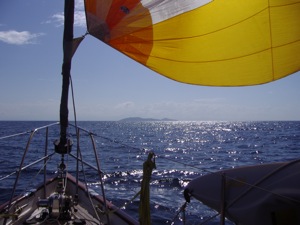
All boats are different and chances are, like us, you’ll be buying a cruising boat with “previous experience”. That’s great because it means the boat’s been through the initial shakedown. Keep in mind that it’s our experience that brand new boat owners don’t necessarily have a challenge free existence. Sometimes they’re more frustrated because their expectation was that everything aboard their brand new boat would work perfectly… we’ve yet to see a boat where everything works perfectly.
When we bought Winterlude, she was a lightly used almost daysailor without much cruising equipment. We’ve managed to sink the boat so much that we’ve had to raise the waterline twice with all the extra equipment. Since we started almost from scratch, we decided to rig the boat so that either of us could do whatever needed to be done alone if something happened to incapacitate the other.
KISS – Keep It Simple — whatever equipment you decide you can’t live without, realize that you are going to have to maintain it. So pick wisely!
SELF SUFFICIENCY . If at all possible, either install any new systems yourself or watch/help as a professional installs it. That way you’ll have some idea of how it’s installed, how the wiring works, if there are fuses on and on. When our refrigeration compressor went whacko last winter we had a refrigeration pro look at it, diagnose the problem and order a new compressor. We could have saved a bit of money by ordering it online ourselves, but we wanted the pro’s help in installation. David watched the entire ordeal and actually installed the compressor himself, with the pro’s supervision, which I’m sure will be useful in the future.
ELECTRICAL SYSTEM . You cannot finalize an electrical system to support your outfitted boat until you have some idea of what you want aboard. Before you go any further, calculate how many amps you think you’ll use with all the goodies aboard and determine what size of battery bank/recharging capabilities you’ll need. I’ll do another post on the intricacies of this calculation, but be sure to think it through. Otherwise you’ll end up not being able to generate enough amps in a day to recharge your batteries which leads to the dreaded running either the generator or the diesel…. disrupting such calm and peaceful surroundings seems criminal! FYI, we have 6 Trojan T-105 wet cell batteries, 220 watts of solar panels (two 55 watt panels on each side), a KISS Wind Generator, a Honda 2000EU portable generator and, a last resort, a Delco 110 amp alternator. We also have an inverter that we rarely use, but are glad we have for recharging batteries in everything from the laptop and handheld GPS/VHFs to the cell phone. Our recharging capabilities are not optimum – we needed at least 45o watts of solar instead of 220, but we didn’t know that at the time because we hadn’t done any real world calculations of how much energy we’d use daily.Our big amp consumers are:
- Galley: Refrigeration, Microwave, Coffee Maker, Seagull Water Filter. – our Adler Barber Super Cold Machine is great, we have ice cubes and everything, but it eats amps like crazy. Be sure your refrigerator is well well insulated. We rarely use our microwave except as a bread box, but it’s there in case the propane system goes out and I need a backup way to cook. The Seagull Water Filter was a brilliant addition, the water directly from our tanks tastes better than most bottled water, but the filters are expensive. Mr Coffee is definitely a luxury every morning.
- Spectra Watermaker – get the highest gallon per hour model that you can afford and fit into whatever space is allotted.
- Laptop Computer/Navigation Systems – laptops just seem to be power hogs. I’ve had Dell, Acer, EEEpc and Macs and all seem to consumer vast quantities of power to recharge.
- Radar, Lights (we’re replacing the lights with LEDs gradually so this is not nearly the amp hog as it used to be)
GO NOW! FORGET ALL THIS STUFF! One caveat for this post. You DO NOT NEED ALL THIS STUFF TO GO CRUISING! Go now, you’ll figure it out. If cruising is your dream, go do it!
Stay tuned! Tomorrow is Part II – Sailing and Safety Equipment and Wednesday is Part III – Outfitting for Your Lifestyle
I’m sure I’ve forgotten a zillion things — anyone have other tips for outfitting the boat before going cruising? Comments? THX! Jan
RELATED ARTICLES MORE FROM AUTHOR

Baby, It’s COLD Inside! Keeping Warm on a Boat
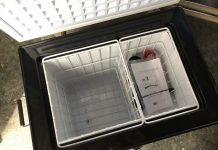
Need More Fridge Space? Try a Portable Refrigerator/Freezer

13 Additions to Optimystique
Great post, but I’m wondering what you mean by ‘raise the waterline’?
Hi Sarah! The point where the boat floats in the water is called the waterline. When we bought Winterlude she had very little cruising equipment, she was basically a daysailing boat. As we added cruising equipment (the Monitor Windvane, new anchor chain & anchors, solar panels, the KISS wind generator, the arch, etc), the boat got heavier and sank lower in the water. There was an inch or so now under the water touching the hull where it didn’t have bottom paint — and without the paint, that section grows slime, some barnacles and worse much quicker than the rest of the bottom with the bottom paint. So when we refer to “raising the waterline” we mean that we’re bringing the antifouling bottom paint up higher on the side of the boat so that where the water touches the boat as it floats has bottom paint. 🙂 We’ve changed ours several times over the years as we’ve added more equipment. 🙂 Cheers! Jan
Thanks for the explanation Jan, in hindsight that should have been obvious. I was really worried that we’ve overloaded Tygress as she rides lower in the water than when we bought her, but she’s still within the anitfouling bottom paint. Plenty of room left then for more shoe and book weight 😉
Seems to me that every cruising boat we’ve encountered is overloaded! 🙂
Out of curiosity, are you running your laptops off their ac power supplies? If you get a dc power supply you tend to waste less energy converting your precious dc power to ac in an inverter and then back to dc for your computer.
Agree completely! Actually yes, I am using a small inverter – not the regular boat inverter – but it still takes more than 12v. I’m also looking at getting a solar charger, although it’s pretty expensive, I could use it on extended trips where we’re camping and may not have charging capabilities. I thought I’d call John at HotWire and see what ideas he might offer. THANKS!
hi, it might be late, but here goes. you can buy a universal laptop dc power supply on ebay for $20 it has different tips and different voltages. I use one on my 1977 lancer 28, powers my dell, vaio, and/or 24 inch flat panel tv, I redid my dc panel to resettable breakers and added 2 cigarette ligter sockets and a 4 port usb charger port, I can charge 4 different usb based toys(ipod,tablet,zune,cellphone)
Thanks Capt Theo! I’m still searching for the perfect solution for powering my laptop. I’ll look on ebay. Thanks! Jan
LEAVE A REPLY Cancel reply
Save my name, email, and website in this browser for the next time I comment.
Notify me of follow-up comments by email.
Notify me of new posts by email.
Currently you have JavaScript disabled. In order to post comments, please make sure JavaScript and Cookies are enabled, and reload the page. Click here for instructions on how to enable JavaScript in your browser.

No Davits? How to Hang a Dinghy.

My New Cuisinart Microwave/Convection Oven is on Sale!
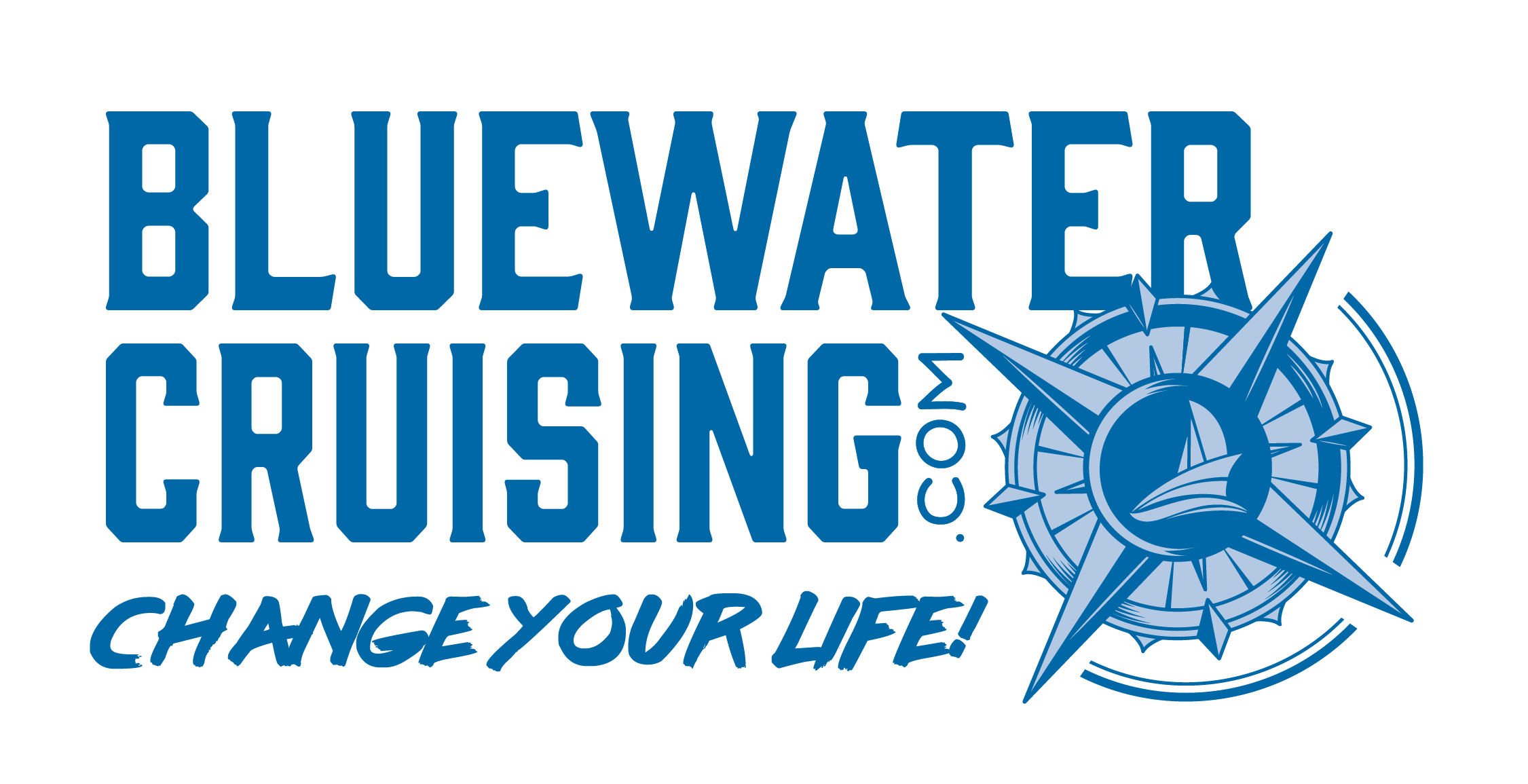
- Bluewater Boat Insurance
- Bluewater Health Insurance
- Member Success
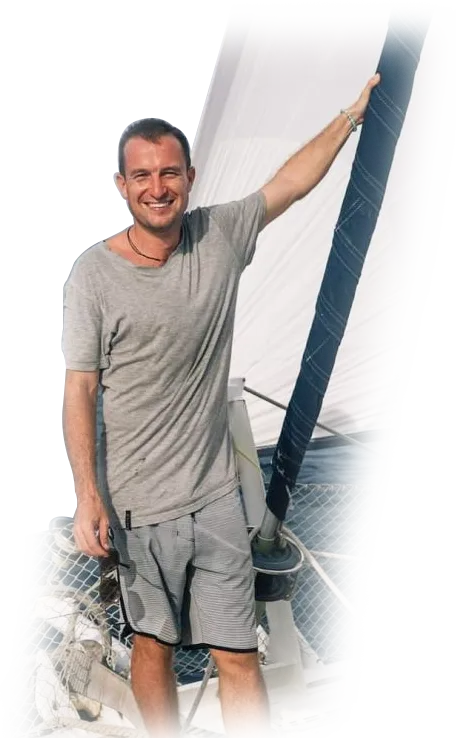
Go through your journey to Bluewater Cruising with our industry leading training programs. Learning how to sail is only 10% of what it takes to change your life and go cruising. We teach the other 90%.
Check out our live, interactive, premium course. Click Learn more to view the details.

Confused to Captain
Live (online).
Jumpstart your journey to Bluewater Cruising with our flagship program
that covers everything from boat buying, outfitting, finances, maintenance,
weather, liveaboard secrets, route planning and much more.
BLUEWATER CRUISING
Compass call.
Let’s hop on a Quick 1 on 1 Compass Call where we can hash out your top 3 challenges to getting started Bluewater Cruising and get you pointed in the right direction. (It’s Free)
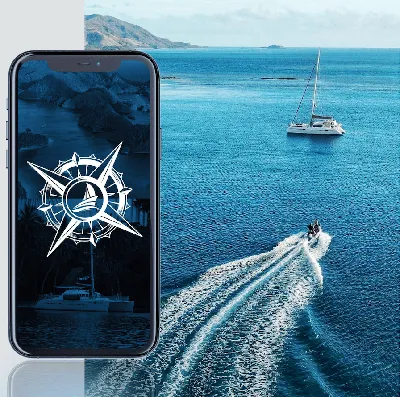
Let’s hop on a quick 1 on 1 Compass call where we can hash out your top 3 challenges to getting started Bluewater Cruising and get you pointed in the right direction. (It’s Free)

© 2024 Bluewater Cruising All Rights Reserved
Privacy Notice | Disclaimer | Terms of Use
To go to our website and order the video click here.

FREE shipping on $100+ Orders
You have no items in your shopping cart.
Enter Your Search Term Below
JavaScript seems to be disabled in your browser. You must have JavaScript enabled in your browser to utilize the functionality of this website.
Outfitting the Offshore Cruising Sailboat

Availability:
Be the first to review this product
PRICE
Description
Specifications, customer reviews.
Write your own review
There are currently no reviews for this product. Click the link above to write a review.
Write A Review
Only registered users can write reviews. Please, log in or register
There are currently no rebates available for this item
Related Products
Related accessories.

Spinlock Deckvest 6D HRS 170N Life Jacket
Regular Price: $409.00
Special Price $339.99

British Admiralty Region 9 Charts - North America (East Coast) and Caribbean

United States Coast Pilots

The Panama Guide 2nd Ed.

Charlie's Charts U.S. Pacific Coast 6th Ed.
- Boats & Parts
- Gifts & Galley
- Training Center
The Navigator
- News & Articles
- Expert Advice
- Safety Alerts
- Shopping cart
- Customer Service
- Shipping Information
- Returns & Refunds
Retail Store
- 151 Harvard Avenue Stamford. CT 06902
- Driving Directions >
- Mon: 9 AM - 5 PM
- Tue: 9 AM - 5 PM
- Wed: 9 AM - 5 PM
- Thur: 9 AM - 5 PM
- Fri: 9 AM - 5 PM
- Sat: 9 AM - 3 PM
- Sun: CLOSED
- Toll Free (800) 941-2219
- Local (203) 487-0775
- Fax (203) 487- 0776
Apparel Deals

Privacy Policy | Terms of Use | Copyright 2023 Landfall Navigation. All Rights Reserved.

Members: Sign in Here --> Members: Sign in Here Contact Us
* * * OffCenterHarbor.com is a membership website with over 1,000 videos and articles on boat handling, repairs, maintenance, boat building, dream boats and more.
Sign up above to learn more, and get 10 of our best videos. * * *
OffCenterHarbor.com is a membership website with over 200 high-quality videos designed to enhance your skills and enjoyment on the water (and in the shop). Sign up to the right for a tour of the site, and we'll send you 10 of our best videos.
Email This Page to a Friend Preview: Outfitting a Small Sailboat with Geoff Kerr
May 22, 2012
Geoff shows us stem to stern how he outfits NED LUDD for a season of beach cruising and island hopping.
Get Free Videos Start Free Trial Members Sign In
– Geoff, it seems as though your boat is incredibly outfitted. We’ve got stern anchors, lines coiled, ready at hand, you know, thick fishermen up forward, bow lines, a couple of fenders, I see a pull off up there which we’ll get into in a little bit. Can you talk us through, you know, kind of, what are the key ingredients to beach cruising and anchoring a small boat for you? – Well, I’ve got kinda got all the toys aboard today. Three weeks ago, I did the Small Reach Regatta with this traditional small boat crowd, and that event’s kinda gear-intensive. They actually inspect and make sure you’ve got all your stuff. So, I’ve got all the toys today. Starting back in the stern, there’s about a 15 pound danforth with ten or so feet of chain, sort of a standard anchor in most of the world. And a handy thing. It’s not necessarily my favorite anchor, but it’s a good lunch hook. It’s a good sandy anchor. Pitiful on rocks, and has it’s drawbacks and its pluses like everything else. The rest of the lines hanging back on this mission partner are a toe line, a couple of dock lines, some spare small stuff for lashing and rigging, anything that comes loose. This is actually a spare halyard just in case because I happen to know that my main halyard’s gettin’ a little worn and could let go. It’s always handy to have the new one. – You’ve got your bucket. – I’ve got my universal soft-rubber bucket which serves many purposes. There’s even a sponge in there for wiping down. That’s kinda the tail end of the boat. Moving forward in the general seamanship world, I’ve got a couple of tubular fenders tied under these seats which are a little extra flotation the way they’re lashed in should something really exciting happen. And they are incredibly handy as rollers for moving the boat around on the beach. – [Interviewer] Right? – Just worth their weight in gold. Oars on the floor, reasonably accessible. This boat takes big oars. They’re 11 feet long. They’re a little unwieldy, and I have just found over the years that even though it takes a second to get ’em free if you need ’em, that’s the most out of the way place. – Right along side your center board. – Right along side the center board, and with the blades flat back here, I can walk around in bare feet and be happy. One piece of small boat gear that I don’t see on a lot of small boats that’s indispensable is actually a boat hook. Particularly single handed. Being able to extend my reach six feet for a dock line or a fouled mission sheet or pushing off a tiling or threatening another boat that’s getting too close. This thing is indispensable. – It’s a beautiful boat hook. – It’s from the German catalog again. Toplicht has medieval looking boat hooks. – All right. – You can buy all sorts of little things. And I just cobbled this together once upon a time when I realized that it could double as my paddle, and this boat being so light, I am either sailing or a few strokes with a canoe paddle, and I can be where I wanna go. I don’t often get the oars out. – Right. – And I combine these into one, and it’s been kind of fun. It’s a handy tool. So moving forward, just ahead of the centerboard case is my trophy on the boat. I’ve got an antique cast-iron 30 pound fisherman. – [Interview] It’s a serious little anchor. – It’s a serious anchor. It’s frankly, way bigger than this boat needs, but this is what my kids and I call the Popeye anchor and we love it, and it just never fails us. This boat rode out a hurricane in Pleasant Bay on Cape Cod one time in four feet of water, 70 mile an hour winds, sitting on that anchor. Never moved an inch. – [Interviewer] That’s amazing. – And every other boat in the harbor was on the beach. So, we take it along even if we don’t need it. It deserves to go for a boat ride. – You got your anchor rope in a basket? What do you carry for anchor rope, Geoff. – I’ve got there, about 250 feet of 3/8th inch nylon. I’ve got thimble spliced in both ends. The end you’re holding in your hands starting from that end, I’ve got it marked in 30 foot increments to kinda keep track of how much road I have out. That’s a critical point. Every anchor has a sweet amount of road it needs to be reliable. – [Interviewer] Right. – And boy, once the first 10 feet goes over, it’s hard to keep track of thin white rope. And– – [Interviewer] It’s keeping your road well marked. – Reasonably marked so you have a clue how much line you’ve got over. Judging the angle is fishy. Lots of things can influence the angle. And it’s important. Classically, a danforth needs a seven to one scope. That’s a lot of rope. Fisherman, you can get away with three to one, especially if it’s really heavy. It’s just important to know. In traditional seamanship books, there was a really classic little system of marking with pieces of leather, and each leather has a different shade, then you can feel it in the night, be all salty and so forth. I do have markers every 30 feet, and it helps me keep track. – [Interviewer] Right. – And I’ve got it flaked out in a basket. That is the easiest most reliable way to have the line feed out cleanly. A big line is a pain to foil and keep to appearance, no matter how good a foiler you are. – So this basket lends itself, open basket style lends itself to being able to have a few shackles. – Yeah, I keep my shackles there. You might find a couple of massed wedges down in the bottom. That’s obviously a very sophisticated piece of marine equipment there. Poke some holes in the bottom so that it drains. If I don’t need it in the boat ’cause I’m just going for a day sail, it can stay in the back of the truck or stay in the garage. It’s good portability. – Right? Couple big fenders going forward. – [Geoff] Yeah, the flare on this boat is so pronounced that it takes a really big diameter fender to give yourself any helper against another boat hull or something. And the volume on those are lashed in solidly. There’s an amazing amount of buoyancy. – [Interviewer] Right? – [Geoff] Should you get swamped, hanging on the mainless partner, the starboard there is a second anchor rode that’s 150 feet and 3/8ths nylon. That’s right off the shelf at the marine supply house. And although it’s in the opposite end of the boat, that’s what I would shackle onto the danforth. And then an out hole… – [Interviewer] While there are many ways to outfit a small boat for beach cruising, Geoff has done an incredible job with Ned Ludd. Thanks for the tour Geoff, and happy beach cruising.
GET THIS FULL VIDEO!
Get Immediate Access, Plus 10 More of Our Best Videos
- Email Address
or …
Start Free Trial
Get Instant Access as a Member to the Entire Site
- Access all 1000 videos/articles
- No risk! Cancel anytime
- Get a nice discount if you join
- BOAT OF THE YEAR
- Newsletters
- Sailboat Reviews
- Boating Safety
- Sailing Totem
- Charter Resources
- Destinations
- Galley Recipes
- Living Aboard
- Sails and Rigging
- Maintenance
- Best Marine Electronics & Technology

15 Tips for Buying a Sailboat
- By Peter Berman
- Updated: October 2, 2019
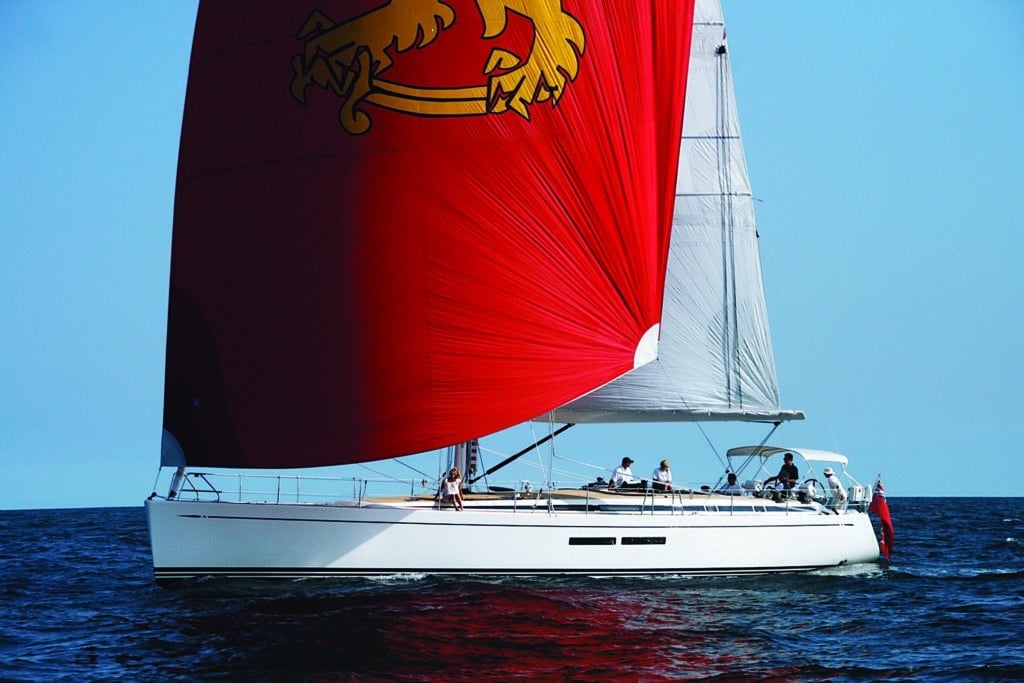
Run a dinghy around any major harbor in the world’s far-flung cruising grounds, and it’s quickly apparent that there’s no such thing as a “perfect” cruising boat. But if you’re in the market for buying a used sailboat or cruiser, the essentials are nearly universal for every sailor: You need a boat that you can readily afford (including the refit and/or outfitting), that meets your specific needs (depending on size of crew and intended itinerary) and that will be saleable afterward. Sure, high-end custom one-offs may be better constructed than “classic plastic” production boats, but that doesn’t necessarily translate into a better cruising experience . Need advice on how to buy a sailboat? Below are some sailboat buying tips divined from owning and sailing more than 100,000 miles in a dozen very different cruisers — from high-tech performance ocean racers to traditional split-rig wooden boats — over several decades.
Tip 1: Remember the 30:70 rule: The builder makes 30 percent of the boat and purchases the remaining 70 percent from other suppliers, almost all of which has to be periodically replaced at ever-higher prices. The 30:70 rule helps explain high rates of depreciation — typically 50 percent after the first decade and 75 percent after the second.
Tip 2: Focus on the total acquisition costs: the purchase price plus the inevitable refit. A good rule of thumb is to use only half the boat budget to buy the sailboat, then employ the other half for the requisite upgrades. A common boat-buying mistake is not reserving enough money for the overhaul. Also, prepare a realistic annual maintenance budget before the purchase. A boat stuck on the dock provides no joy.
Tip 3: Avoid being beguiled by a long list of equipment and cosmetic touch-ups. Fact: Most equipment will probably require replacement. Also, brokers and sellers know that cosmetics help sell boats, but they don’t make them sail any better. Similarly, view claims of a “recent refit” with skepticism. Does new anchor chain or new sails make the boat worth more when chain and sails are part of a boat’s normal complement of gear? (And that actually may be a “yes” when it comes to sails, but rarely will you find a used boat with a new inventory.)
Tip 4: The major refit costs will likely involve the rig and engine. After 15 to 20 years, it’s long past time to pull the mast, upgrade the standing rigging and terminals, take apart the spar and inspect for crevice corrosion and cracks, replace blocks, inspect the sheaves and mast step, and beef up gear as necessary. For extended offshore use, the general rule is to replace everything with heavier rigging and equipment. Losing a mast offshore makes for a very bad day. Paint makes masts look better but often hides corrosion.
Tip 5: Likewise, after two decades, it’s time to pay the “engine piper” — or pay him later. There are basically two options: rebuild what’s already installed (saving half the cost) or repower with a new engine. Typically, the in-and-out labor costs are equal to the cost of a rebuilt or new engine. Changing engine brands can significantly add to the price. Remember, many experienced cruisers cover as many as half their miles under power (especially those running up and down the Intracoastal Waterway). So a reliable engine is essential. No one ever complains when it starts up every time! Also, budget for ample spare parts; obtaining them in distant ports can be a real headache.
Tip 6: Nothing improves comfort more than size. Within limits, everything on the boat can be changed except size. But size is a double-edged sword, as costs and maintenance even in slightly larger boats are disproportionately higher. As size increases, so does volume. A 40-footer will have twice the volume of a 30-footer. When discussing size, focus on the waterline length. Length matters because size yields more storage space and more accommodations, and longer boats tend to sail faster, with a smoother motion. Bigger boats also provide the ability to take on additional crew for longer passages.
Tip 7: The boat’s gear is one of the most important factors to consider when buying a sailboat. With the right gear, including electric winches for furling mains or halyards, a senior couple in reasonably good condition can take a 60-footer offshore. But the maintenance and operating costs of such a vessel can approach six figures yearly. Most cruising is done in affordable vessels in the 40-foot range, where traditional gear gets the job done. All that said, when cruising really took off in the 1960s and 1970s, a 25-foot fiberglass production boat was often considered big enough for offshore work.
Tip 8: As mentioned at the outset, there’s no such thing as a perfect cruising boat, no matter how large the budget. Moreover, one’s notion of an ideal cruiser changes with experience, intended usage and age. Boats are always works in progress. Center cockpits with island double berths have nice accommodations for dockside use. For offshore sailing, on the other hand, and especially if they eschew island doubles for snug sea berths, aft cockpits enhance the sailing experience. Jib furlers and electric winches make life easier but also can introduce cost and maintenance issues. Everyone underestimates the cost of owning and operating a functioning cruising boat.
Tip 9: Beware of fancy joiner work and the liberal use of external teak. It’s nice to look at, but it doesn’t make the boat perform any better and is costly and/or time-consuming to own and maintain. Similarly, unless you have deep pockets, avoid teak decks. (Teak is lovely, but it’s also awfully hot in the tropics.) Whether screwed or glued, after 15 years, teak decks are typically ready for replacement, nowadays at a cost that would buy a nice cruising sailboat.
Tip 10: Given the choice, opt for a boat drawn by a reputable naval architect over one from a builder who designed his own boats. I’ve found that the collaborative efforts produce better boats. Pay special attention to designers and builders who focus on cruisers, not raceboats. When you’ve narrowed down a prospect, learn about the boat’s history, talk to owners of similar boats and experienced surveyors, and, when applicable, contact the club associations of respective models, which can be good sources of information. Whatever you’re considering, remember that a boat that’s “lived in the islands” is apt to have had a hard life.
Tip 11: If you’re truly considering long-range cruising, think long and hard about the boat’s accommodations for use offshore. Double berths in the bow or stern are wonderful in port, as are swivel chairs in the main saloon. Without functional sea berths amidships, however, the crew will wind up sleeping on the cabin floor and asking when the trip will be over. Any sea berth worthy of its name is a minimum of 7 feet long and has a proper lee cloth.
Tip 12: Like Napoleon’s armies, crews travel on their stomachs. Spacious galleys are fine alongside a dock, but at sea you need a galley where the cook is secure and the pots and pans stay off the cabin sole. If you really want to eat well offshore, nothing beats a large freezer or crews handy with a rod and reel.
Tip 13: Marine toilets can and do fail, usually at the most awkward time. Spares help, but a second head is better. Repairing a head when underway is probably the worst job afloat.
Tip 14: Regardless of your budget or the size of your vessel, take safety seriously. That means a certified ocean life raft, EPIRBs, SOLAS-rated and -equipped life jackets with harnesses, a VHF radio with AIS, ample bilge pumps and even a sat phone if voyaging offshore. Before loading up on electronics, cover the safety gear. Sure, it’s nice to have an SSB radio, a big-screen chart plotter, an autopilot, a TV, a Wi-Fi router and so on. But buy the life raft first — if not for yourself, then for your crew and loved ones (even if they’re not sailing with you).
Tip 15: When in doubt, walk away. Unless the boat inspires real passion, it’s the wrong boat. Find the most competent and highly regarded surveyor available. Ask him or her about the required refit and likely costs involved. I’ve never regretted walking away from, or spending the money on, a “problem” survey. Make sure you have a serious sea trial — and not just a short run with the engine, and a quick raising and lowering of sails — in a good breeze. Even very experienced sailors can fail to note the obvious on sea trials, especially rushed ones.
Looking back on the cruising boats I’ve owned, my favorite was a fiberglass 45-foot ketch built in the early 1970s with an aft cockpit, a centerboard and double headsails. It had none of the amenities we now take for granted (a small portable generator handled the “electrics”), yet we fairly scooted across the Pacific. Close behind was a 35-foot block-and-tackle wooden ketch built in the 1960s, with no winches. The larger boat is still going strong in the islands, the smaller one in Alaska. So that’s my final tip: You can sail a long way on a simple boat.
An engineer by training with over four decades of experience voyaging in the Atlantic, the Pacific and the Caribbean, Peter Berman is the author of Outfitting the Offshore Cruising Sailboat (Paradise Cay Publications, 2011).
Read about: Boat Buying | Sailboat Reviews
- More: boat buyer's guide , How To , Sailboats
- More How To
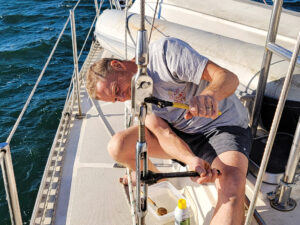
How to Rig Everything in Your Favor
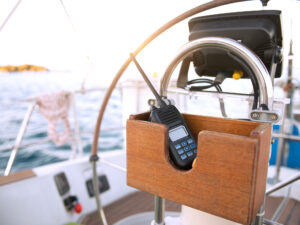
Is There a Doctor Aboard?

3 Clutch Sails For Peak Performance

It’s Time to Rethink Your Ditch Kit
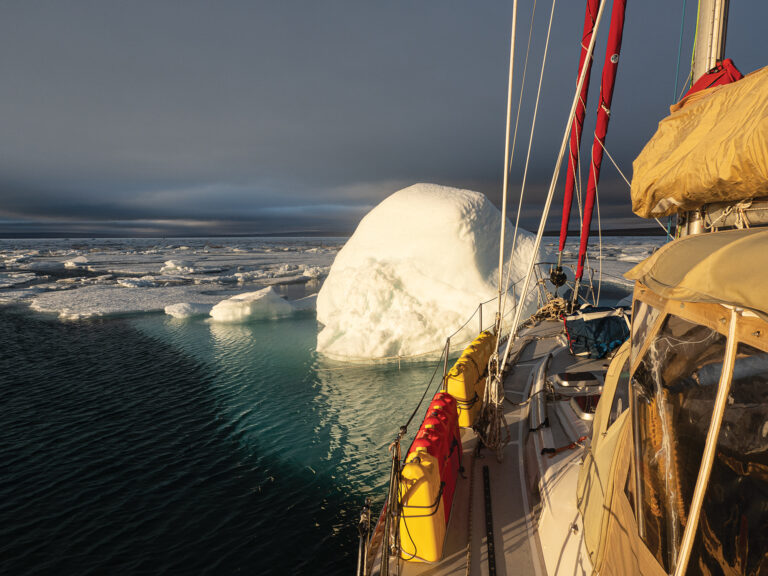
Cruising the Northwest Passage

Balance 442 “Lasai” Set to Debut
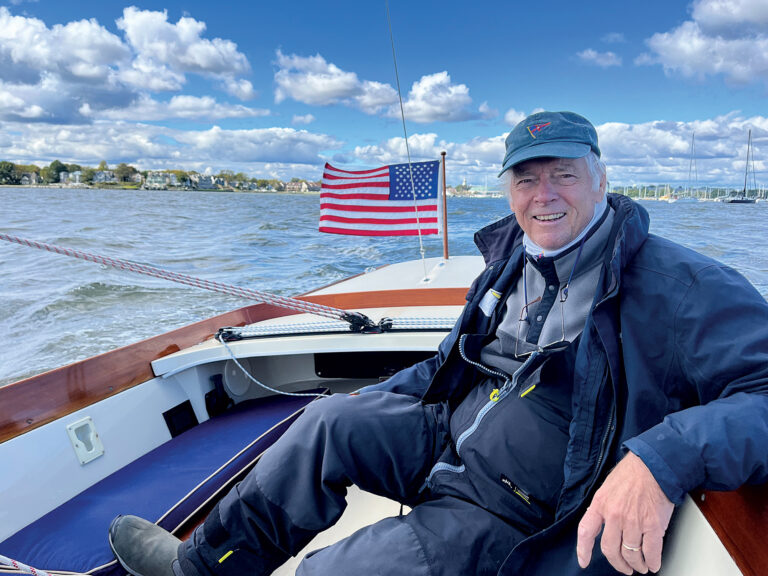
A Legendary Sail

10 Best Sailing Movies of All Time
- Digital Edition
- Customer Service
- Privacy Policy
- Email Newsletters
- Cruising World
- Sailing World
- Salt Water Sportsman
- Sport Fishing
- Wakeboarding

- Sails & Canvas
- Hull & Structure
- Maintenance
- Sailing Stories
- Sailing Tips
- Boat Reviews
- Book Reviews
- Boats for Sale
- Post a Boat for Sale
- The Dogwatch
- Subscriptions
- Back Issues
- Article Collections
- Free for Sailors
Select Page
Outfitting the Offshore Cruising Sailboat: Book Review
Posted by Karen Larson | Book Reviews , Dogwatch , Reviews

His 45-year experience as a cruiser in nearly a dozen different designs (CCA through modern racing designs) is enlightening. While Peter has formed strong opinions about many features, he does not recommend one design type over another. He knows, perhaps better than most, that every sailboat is a compromise and that priorities and budgets will vary from sailor to sailor.
What he offers is a series of observations and a logical review of onboard systems that will help any prospective offshore cruiser consider the pros and cons of each system, feature, and sailboat type. In the end, the reader of Outfitting the Offshore Cruising Sailboat will be able to determine which features are personally important and which have a lower priority.
I chuckled occasionally at Peter’s dry wit but found that I didn’t agree with every word of his sage advice. I’m just one sailor, after all, with one set of values and preferences, but I was surprised, for example, to note that Peter overlooked the value of freshwater sailboats, as they apparently do not figure in the experience of this East Coast (and beyond) sailor.
Peter starts his discussion of good used boats by ranking the most expensive systems: the rig, the engine, and the ground tackle. As these are the most expensive items to replace, he gives each system a thorough and thoughtful critique based on his experiences as a cruiser. There are many nuggets here for every would-be cruiser. In particular, he includes good tips about good and bad construction features in the rig, bearing in mind intended use for coastal vs. offshore work. This section clearly spells out features to look for if you will be cruising offshore.
Over all, Peter offers great advice about buying a good old cruising sailboat and how to refit it for several more decades of offshore cruising adventures. Like the rest of us, Peter has conflicts about the best possible cruising sailboat. After saying that larger is always better, that system redundancy is critically important, and that you should replace practically everything before going offshore, Peter admits that his first cruiser was probably his favorite. A primitively equipped wooden Dickerson, this boat cost only $16,000, had fewer systems to maintain, and was his most affordable cruiser. After telling readers they should probably invest the purchase price of the boat in the refit, and to replace all the important and expensive systems, he reminds us that the first priority is to “just go.” Time is the enemy, he says, so don’t spend your life in “endless outfitting.”
In the end, as in all things, it’s up to the reader to make his own choices based on his own list of priorities. But Peter offers great advice that may help each reader rank his own list of priorities and consider some systems and construction methods that he may not have thought about.
If you’re still searching for your offshore sailboat and juggling the hundreds of variables, Peter Berman — a guy who’s been there and done that — has some very useful advice for you.
Read this book. Then go get the boat, get to work on the refit, and get going . . . now —while you can.
Outfitting the Offshore Cruising Sailboat: Refitting Used Sailboats for Bluewater Voyaging by Peter I. Berman (Paradise Cay Publications, 2012; 256 pages)
About The Author

Karen Larson
Karen Larson and her husband, Jerry Powlas, began sailing together in 1990 and founded Good Old Boat magazine together in 1998. Retired these days, they still have too many boats and a long list of ongoing boat projects. They sail Mystic, their C&C 30, on Lake Superior and Sunflower, their trailerable Mega 30, during the shoulder seasons.
Related Posts
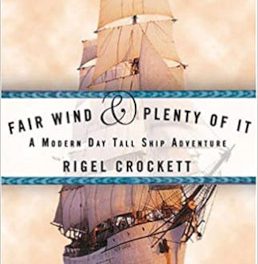
Fair Wind and Plenty of It: Book Review
August 1, 2005

Celestial Navigation in the GPS Age: Book Review
June 1, 2008
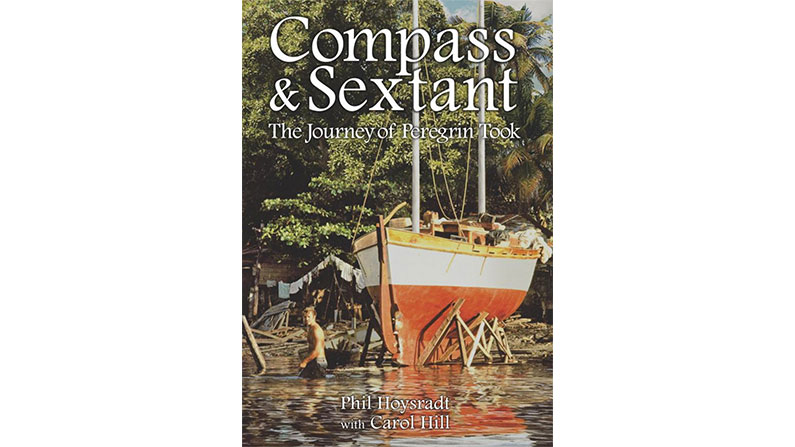
Compass & Sextant: The Journey of Peregrin Took Book Review
October 15, 2019
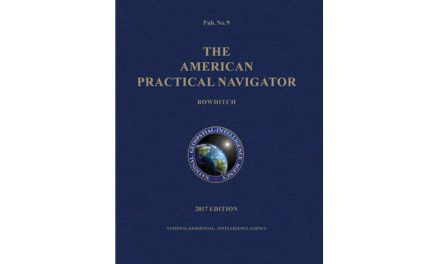
The American Practical Navigator ‘Bowditch’ Book Review
August 13, 2019
Now on Newsstands
Join Our Mailing List
Get the best sailing news, boat project how-tos and more delivered to your inbox.
You have Successfully Subscribed!

- Engineering & Transportation
- Transportation

Enjoy fast, free delivery, exclusive deals, and award-winning movies & TV shows with Prime Try Prime and start saving today with fast, free delivery
Amazon Prime includes:
Fast, FREE Delivery is available to Prime members. To join, select "Try Amazon Prime and start saving today with Fast, FREE Delivery" below the Add to Cart button.
- Cardmembers earn 5% Back at Amazon.com with a Prime Credit Card.
- Unlimited Free Two-Day Delivery
- Streaming of thousands of movies and TV shows with limited ads on Prime Video.
- A Kindle book to borrow for free each month - with no due dates
- Listen to over 2 million songs and hundreds of playlists
- Unlimited photo storage with anywhere access
Important: Your credit card will NOT be charged when you start your free trial or if you cancel during the trial period. If you're happy with Amazon Prime, do nothing. At the end of the free trial, your membership will automatically upgrade to a monthly membership.
Buy new: $19.95 $19.95 FREE delivery: Tuesday, April 2 on orders over $35.00 shipped by Amazon. Ships from: Amazon.com Sold by: Amazon.com
Return this item for free.
Free returns are available for the shipping address you chose. You can return the item for any reason in new and unused condition: no shipping charges
- Go to your orders and start the return
- Select the return method
Buy used: $7.00
Other sellers on amazon.

Download the free Kindle app and start reading Kindle books instantly on your smartphone, tablet, or computer - no Kindle device required .
Read instantly on your browser with Kindle for Web.
Using your mobile phone camera - scan the code below and download the Kindle app.

Image Unavailable

- To view this video download Flash Player

Outfitting the Offshore Cruising Sailboat Paperback – Illustrated, August 1, 2012
Purchase options and add-ons.
- Print length 256 pages
- Language English
- Publisher Paradise Cay Publications
- Publication date August 1, 2012
- Dimensions 6 x 0.75 x 8.75 inches
- ISBN-10 0939837994
- ISBN-13 978-0939837991
- See all details

Frequently bought together

Customers who bought this item also bought

Editorial Reviews
From the back cover.
In Outfitting the Offshore Sailboat, Peter Berman reviews the criteria for selecting a used fiberglass hull sailboat, but picks up where Vigor and Nestor leave off. Berman shares his 40+ years' experience of overhauling and refitting a myriad of different sailboats in preparation for offshore voyaging. Follow the information offered in Outfitting the Offshore Sailboat and you can buy and refit a cruising sailboat for a fraction of the cost of buying a new boat.
About the Author
Product details.
- Publisher : Paradise Cay Publications; Illustrated edition (August 1, 2012)
- Language : English
- Paperback : 256 pages
- ISBN-10 : 0939837994
- ISBN-13 : 978-0939837991
- Item Weight : 15.2 ounces
- Dimensions : 6 x 0.75 x 8.75 inches
- #233 in Ship Repair & Maintenance
- #1,562 in Sailing (Books)
- #189,212 in Reference (Books)
Customer reviews
Customer Reviews, including Product Star Ratings help customers to learn more about the product and decide whether it is the right product for them.
To calculate the overall star rating and percentage breakdown by star, we don’t use a simple average. Instead, our system considers things like how recent a review is and if the reviewer bought the item on Amazon. It also analyzed reviews to verify trustworthiness.
- Sort reviews by Top reviews Most recent Top reviews
Top reviews from the United States
There was a problem filtering reviews right now. please try again later..
Top reviews from other countries
- Amazon Newsletter
- About Amazon
- Accessibility
- Sustainability
- Press Center
- Investor Relations
- Amazon Devices
- Amazon Science
- Start Selling with Amazon
- Sell apps on Amazon
- Supply to Amazon
- Protect & Build Your Brand
- Become an Affiliate
- Become a Delivery Driver
- Start a Package Delivery Business
- Advertise Your Products
- Self-Publish with Us
- Host an Amazon Hub
- › See More Ways to Make Money
- Amazon Visa
- Amazon Store Card
- Amazon Secured Card
- Amazon Business Card
- Shop with Points
- Credit Card Marketplace
- Reload Your Balance
- Amazon Currency Converter
- Your Account
- Your Orders
- Shipping Rates & Policies
- Amazon Prime
- Returns & Replacements
- Manage Your Content and Devices
- Recalls and Product Safety Alerts
- Conditions of Use
- Privacy Notice
- Your Ads Privacy Choices
You are using an outdated browser. Please upgrade your browser to improve your experience.
New! Disney Cruise Line Summer 2025 Itineraries
Video shows Carnival Freedom on fire, again. Two upcoming cruises were canceled. Here's what to know
The Carnival Freedom 's next two sailings have been canceled after the cruise ship, based out of Florida, caught fire . Again.
Carnival initially said there were no expected changes in its schedule but on Sunday afternoon announced cancellations of the Monday and Friday cruises out of Port Canaveral, which come during a busy spring break period.
"Regrettably, the damage is more than we first thought, and will require an immediate repair to stabilize the funnel, resulting in the cancellation of the March 25 and March 29 cruises from Port Canaveral," according to a statement issued by Matt Lupoli, Carnival Cruise Line's senior manager of public relations. "The funnel has been stabilized for the ship’s return to Port Canaveral overnight to disembark guests, and then it will go to the Freeport shipyard on Monday afternoon to begin the required repairs."
This is the second time in less than two years this cruise ship's funnel has caught on fire and disrupted the schedule.
Carnival cruise fire: Carnival Freedom's next two cruises from Port Canaveral canceled after exhaust funnel fire
When did the Carnival Freedom catch on fire?
The fire broke out on the port side of the ship's exhaust funnel area at about 3:15 p.m. Saturday, Carnival said.
The ship was 20 miles off Eleuthera Island, Bahamas. It was intended to call on the Carnival private island of Princess Cay but had rerouted toward Freeport due to adverse weather.
"The ship’s fire response team was quickly activated, and the ship’s captain also turned the vessel towards the heavy rain in the area to maximize the efforts to put out the flames," an earlier Carnival statement said. The fire was put out by 5:20 p.m., the cruise line said.
Why did the Carnival Freedom cruise ship catch fire?
Unknown at this time.
"Eyewitnesses reported the possibility of a lightning strike, and that is being investigated," Carnival said, "but cannot yet be confirmed."
Was anyone hurt in the Carnival Freedom fire?
The cruise line said there were no reports of passenger injuries, although two firefighting crew members were treated for minor smoke inhalation and part of the funnel fell onto Deck 10, according to Carnival.
There were about 3.700 passengers aboard.
Which Carnival Freedom cruises have been canceled?
While initially the cruise line said the schedule would not be affected, further investigation found more damage than suspected. Scheduled cruises for Monday, March 25 and Friday, March 29 have been canceled.
Can I get a refund for my canceled Carnival Freedom cruise?
"We sincerely regret the impact to our embarking guests, as we know they have been looking forward to their spring break vacation<' Carnival Cruises said in a statement. "We are providing all guests on both canceled cruises a full refund and a 100% future cruise credit, so they can come back and enjoy a future cruise with us. We also greatly appreciate the terrific guests who are currently sailing with us, for their outstanding cooperation and support."
Where is Port Canaveral?
Port Canaveral, Florida is located on a barrier island between the Banana River and the Atlantic Ocean just north of Cape Canaveral. The port is 54 miles from Orlando and 75 miles from Daytona Beach.
What is the funnel on a cruise ship?
A cruise ship exhaust funnel works as a smokestack to lift emissions away from the deck and from passengers and crew. They're often called stacks.
The Carnival Freedom debuted a new stylized winged funnel in October last year after a 16-day dry-dock refurbishment in Cadiz, Spain. Carnival cruise funnels are referred to as the whale tail.
Has the Carnival Freedom cruise ship caught on fire before?
A fire broke out in the funnel area in May 2022 while it was docked in Grand Turk. Three scheduled sailings were canceled while the ship was repaired at a shipyard in Grand Bahama.
The ship was carrying about 2,500 passengers at the time and a crew of about 1,100, according to the cruise line. There were no injuries reported.
Which cruise ship caught fire?
The Carnival Freedom caught on fire on Saturday, March 23.
The 110,000-ton vessel made its inaugural sail in 2007. The Freedom, which has 13 decks, can hold up to 3,754 passengers and 1,150 crew members.
Has a Carnival cruise ship ever sank?
No. But one has been shipwrecked.
On Jan. 13, 2012, the Costa Concordia struck a reef and capsized off the Tuscan island of Giglio. The ship, which was owned by a Carnival Corporation subsidiary, when the captain steered the 952-foot, 13-deck ship close to the shore to "impress the passengers" and tore a 160-foot gash in the port hull.
Captain Francesco Schettino was found guilty of manslaughter in 2015 and sentenced to 16 years in prison for the deaths of 32 passengers and crewmembers.
- Life & Culture
What’s it like to dine on Tampa’s new riverboat cruise Craft? We took a ride
- Helen Freund Times staff
TAMPA — We almost didn’t make the boat.
Traffic snarled through downtown Tampa and stretched onto the Lee Roy Selmon Expressway, delaying what would have been a 45-minute drive from St. Petersburg to nearly an hour and a half in stop-and-go congestion.
We had reservations for Craft, Tampa’s brand new riverboat dinner cruise set to depart at 7:30 p.m. — and a friendly confirmation email reminding us that our purchase was non-refundable. We’d been encouraged to arrive 45 minutes early, when we would have presumably been able to commence a leisurely boarding, river breeze in our hair, champagne flute in hand.
Life had other plans. At 7:25 p.m., my dinner date and I swung our car into the Garrison Street parking lot, narrowly avoiding getting struck by an oncoming streetcar.
Following a quick security wand-down (the boat adheres to U.S. Coast Guard rules) and a $30 event-fueled parking fee (Tim McGraw was playing a show at nearby Amalie Arena), crew members greeted us with a quick photograph and a glass of bubbly before sending us on our way.
“Welcome to our maiden voyage!” they exclaimed as we rushed aboard.
Shortly after 7:30 p.m., we were off, out of the Ybor Turning Basin and into the sunset.
Described as a “culinary and cocktail river journey,” Craft debuted its inaugural dinner cruise on March 15. The multi-million-dollar project is the latest endeavor from Jill and Troy Manthey, who also run several other entertainment-on-the-water concepts, including Yacht StarShip, Pirate Water Taxi and the Bay Rocket.
Designed with European river boats in mind, the 130-foot-long vessel boasts a sleek, white silhouette with less than 11 feet of vertical clearance — meaning it can comfortably drift beneath many of Tampa’s low-lying bridges. But this ship’s real appeal lies in the coupling of an elevated culinary program, contemporary aesthetic and craft cocktails.
A trip aboard Craft includes a two-hour cruise up and down the Hillsborough River and a three-course prix-fixe meal. To start, there are lunch, brunch and dinner trips on deck, but a happy hour option may soon be in the works.
Running any kind of marine operation comes with steep operating costs — including fuel, dock rental fees and staffing — and the experience here is priced accordingly. But it still comes with a good deal of sticker shock. For two people on a Friday evening, we paid $392.59 for the boat ride and the three-course dinner — not including gratuity or drinks.
Dig in to Tampa Bay’s food and drink scenes
Subscribe to our free Taste newsletter
You’re all signed up!
Want more of our free, weekly newsletters in your inbox? Let’s get started.
I love a fancy boat ride as much as the next person, but the pricing gave me pause.
Would the experience be worth it?
Things were a lot smoother once we got on board.
We entered through the front of the boat, or bow, and were shown to our seats inside a narrow dining room, flanked by windows overlooking the water. Wood paneling combined with slight nautical touches lent the space a warm, industrial chic vibe.
Servers clad in white collared shirts and gray aprons whisked back and forth between the tables, balancing martini coupes and taking orders. In an attempt to let the crew develop their sea legs, the boat wasn’t fully booked that evening, but the dining room still felt abuzz with excitement and curiosity.
Clutching our champagne, we glided through Sparkman Channel at dusk, glitzy Harbour Island homes glowing in the evening light as a Maggie Rogers track played softly in the background. We let out a collective exhale as the chaos of the day faded away.
Over the course of the roughly two-hour cruise, the boat steered up the Hillsborough River, passing Riverwalk landmarks including the Tampa Convention Center, Armature Works and Ricks on the River, before turning around and heading back.
Guests were encouraged to explore the boat. The Bow and Stern bar, beautifully designed and fashioned out of a vintage 1914 cruiser, provided additional seating in the rear for those looking for more of an al fresco experience.
Throughout the evening, the crew moved back and forth between the dining room, the bar and the kitchen, sometimes stepping out on the deck to alert passengers when their meals had been delivered. Guests roamed the boat taking photographs, while patrons inside chatted up their neighbors, much of the voyage illuminated by the lights of downtown Tampa.
Craft’s strongest selling point is its culinary program, and the menu here is a far cry from the goblets of white wine and dry chicken associated with most dinner cruises.
Designed by chef Allison Beasman (formerly of Edison: Food + Drink Lab), the list of contemporary New American dishes runs the gamut from a black grouper served with Little Neck clams and Pernod cream to a Wagyu coulotte with kabocha caramel and a Korean barbecue octopus. As part of the prix-fixe deal, guests are able to pick an appetizer, entree and dessert from a menu of roughly 13 different dishes.
Part of what makes the vessel stand out is the addition of an open kitchen with gas stoves, and the concept’s design allows guests to get a peek of the action if they’re on their way to the bathroom or the bar.
When it came time to order dinner, our server patiently guided us through the menu, pointing out the additional dishes we could choose if we wished to add a little something extra onto our pre-paid meal. We opted for the olive oil-marinated sheep and goat’s milk cheese ($18), which was just as tasty as our server touted. It arrived in a rich red pepper-packed pisto, drizzled with a healthy glug of olive oil and served with crusty bread for dipping.
Dishes are made to order and don’t necessarily arrive at the same time as other passengers’ meals. Our appetizers showed up roughly 45 minutes into the trip, a delightful baby kale salad lightly dressed in a white balsamic vinaigrette that was toothsome with chicory and shaved carrots and plumped up with fried baby potatoes and a healthy shaving of ricotta salata. Also good was the hearty tomato bisque with roasted bone marrow and blackened cipollini onions.
For our entrees, a seared duck breast arrived fanned out over silky whipped potatoes and a creamy goat cheese fondue, framed by Brussels sprouts and fat wedges of roasted golden beets. Though the duck was cooked a little past the requested temperature, it was still delicious. A plate of sweet and sour braised short ribs packed powerhouse flavors that paired beautifully together, all served over a sweet and sticky coconut rice sidling bok choy and juicy tangerine segments.
For dessert, we paired a perfect few scoops of pistachio ice cream with a chocolate espresso dacquoise, an intensely rich and sweet layer cake featuring a tart blackberry curd and creamy dark chocolate ganache.
The fine print
The water was calm that night and the entire service appeared well-rehearsed — absent of any major hiccups and even graceful at moments. As far as I could tell, there were no sea sick passengers or man-overboard scenarios, which felt like some kind of success, though I did wonder what type of balance or physical dexterity would be required to maneuver trays of wobbling martini glasses over stormier seas.
Though tiered pricing exists for Craft — for different seats, times of day or days of the week — there’s no overlooking that a trip aboard the vessel isn’t cheap.
With neither drinks nor gratuity included in the booking price, if you’re looking to enjoy the evening with a couple of libations, it’s going to cost you. The add-ons can feel excessive, from a $50 king crab leg tray to the pre-boarding photograph crew members try to sell you at the end of the night. A suggested gratuity is presented on your bill, based on the total sales tallied for the table that evening, including the cost of the original reservation.
Some changes are bound to be expected as the company assesses guest interest and feedback. Even after the first week, it appears some prices have been slightly adjusted. Dinner for two people seated in the dining room with window seats now comes to $369.89 after taxes and marine fees, while weekend brunches for the same seats start at $89.95 per person.
It’s hard to imagine making dining here a regular occurrence, but for a special occasion, an evening aboard Craft can be a real delight.
Next time, though, I’ll remember to leave myself plenty of time to get there.
Helen Freund is the food and dining critic, reporting on and reviewing restaurants throughout Tampa Bay. Reach her at [email protected].
MORE FOR YOU
- Advertisement
ONLY AVAILABLE FOR SUBSCRIBERS
The Tampa Bay Times e-Newspaper is a digital replica of the printed paper seven days a week that is available to read on desktop, mobile, and our app for subscribers only. To enjoy the e-Newspaper every day, please subscribe.
Baltimore cruises to reroute after bridge collapse pauses port traffic
Carnival will move some operations to norfolk while baltimore recovers from key bridge collapse.

Cruise lines are scrambling to make alternative plans and avoid the Port of Baltimore while officials suspend vessel traffic amid cleanup and rescue efforts around the Francis Scott Key Bridge collapse.
Three major cruise lines sail from Baltimore, though no ships were in port Tuesday morning. The next cruise was scheduled to depart Sunday, but its operator confirmed late Tuesday afternoon that the voyage would instead head out from Norfolk.
Amira M. Hairston, a spokeswoman for the Baltimore port, said in an email that the status of the upcoming cruise ship schedule is not yet known.
“At this time we do not know how long vessel traffic will be suspended. As soon as that is determined we will provide an update. Until then please keep those involved in your prayers,” Hairston wrote.
Royal Caribbean International’s Vision of the Seas left Saturday for a 12-night southern Caribbean cruise with plans to return April 4. The cruise line said in a statement that it was “closely monitoring the situation, and our port logistics team is currently working on alternatives for Vision of the Seas’ ongoing and upcoming sailings.”
“We are deeply saddened by the tragedy and collapse of the Francis Scott Key Bridge and extend our heartfelt prayers to all those impacted,” the company said. Royal Caribbean International will contact guests and travel partners once plans are final, the operator said.
Carnival Legend set off Sunday for a seven-day Bahamas cruise; the ship was scheduled to return March 31 and depart for its next sailing the same day. Instead of coming back to Baltimore, Carnival said late Tuesday, it will end its trip in Norfolk, and free buses will bring passengers back to Baltimore.
The ship’s next seven-day cruise will leave Norfolk and return to the port. In a news release , Carnival said it would temporarily move Baltimore operations to Norfolk “while Key Bridge rescue and cleanup efforts continue.”
“Our thoughts remain with the impacted families and first responders in Baltimore,” Christine Duffy, president of Carnival Cruise Line, said in a statement. “We appreciate the pledge made by President Biden today to dedicate all available resources to reopen Baltimore Harbor to marine traffic as soon as possible. As those plans are finalized, we will update our future cruise guests on when we will return home to Baltimore, but in the meantime, we appreciate the quick response and support from officials in Norfolk.”
Carnival Pride is supposed to start sailing from Baltimore next month, mostly to the Bahamas and eastern Caribbean.
Norwegian Cruise Line does not have cruises scheduled out of the port until later this year. American Cruise Lines, a U.S. river cruise operator, has Chesapeake Bay trips on small vessels scheduled from Baltimore starting in May. The cruise line said it will monitor developments “and make adjustments if needed.”
Cruise Lines International Association (CLIA) said it was “deeply saddened” by the bridge collapse and was closely following the situation. “Right now, the most important thing to do is to allow the emergency workers to do their work,” the group wrote in a statement.
This year, 12 ships are scheduled to make a total of 115 calls at the Port of Baltimore, the industry association said. With room for roughly 2,000 or 2,100 passengers at double occupancy, most Baltimore-based ships are much smaller than the record-breaking behemoths that sail from Florida ports.
“Any adjustments to current cruise activity at the port will be announced as soon as available by the individual cruise lines,” CLIA said in its statement.
A news release issued last month by Maryland Gov. Wes Moore’s office said that more than 444,000 individuals cruised out of the Port of Baltimore last year, the most since 2012. The Maryland Port Administration said in a news release last year that the cruise industry generates nearly 400 jobs and $63 million in revenue every year for local businesses.
The port positions itself as a convenient option for cruising year-round, thanks to its location off Interstate 95 and plentiful parking. More than 40 million people live within a six-hour drive of the city, the port administration says.
Baltimore bridge collapse
Baltimore’s Francis Scott Key Bridge collapsed after being hit by a cargo ship , sending at least eight people from a construction crew into the water. Two people were rescued and the remaining six are presumed dead, officials said. Follow live updates and see photos from the scene .
How it happened: The container ship lost power moments before colliding with the bridge, Maryland Gov. Wes Moore (D) said. Video shows the bridge collapse in under 40 seconds.
Victims: All six missing victims are presumed dead, the U.S. Coast Guard said, and the agency has ended rescue efforts. The entire crew aboard the 985-foot container ship Dali survived . First responders shut down most traffic on the four-lane bridge after the crew issued an urgent “mayday.” It saved lives, Moore said.
Economic impact: The collapse of the bridge, which severed ocean links to the Port of Baltimore, adds a fresh headache to already struggling global supply chains . See how the collapse will disrupt the supply of cars, coal and tofu .
History: The Key Bridge was built in the 1970s and spans the Patapsco River. Rebuilding the bridge over the Patapsco River will probably take years and cost hundreds of millions of dollars, experts said.

Port of Baltimore suspends ship traffic after bridge collapse: What it means for travel
Travel is being impacted by Tuesday’s Francis Scott Key Bridge collapse along Interstate 695 in Baltimore, Maryland.
Drivers were immediately directed to take alternate routes through the city, following the early morning incident. What’s less clear is what the bridge collapse may mean for upcoming cruises in and out of Baltimore.
“Vessel traffic into and out of the Port of Baltimore is suspended until further notice,” the Port of Baltimore posted on X, formerly Twitter.
Live Updates: Baltimore's Key Bridge collapses after ship hits it; construction crew missing
Rep. Kweisi Mfume, D-Md., whose district includes the bridge and the port, called the collapse an “unthinkable horror” and said he had spoken with Transportation Secretary Pete Buttigieg and the White House.
Learn more: Best travel insurance
“They are responding with all of the assets at their disposal,” he said in a statement. “Our prayers right now are for the missing individuals and victims of this tragedy. We thank God for the effective service of our first responders.”
Here’s what we know.
Which cruises go to Baltimore?
Several major cruise lines serve Baltimore. According to the Cruise Lines International Association, the industry’s leading trade group, published itineraries in the 2024 calendar year include a dozen ships making 115 stops in Baltimore.
“We are deeply saddened by the tragedy and collapse of the Key Bridge that occurred last night and extend our support and heartfelt prayers to all those impacted,” CLIA spokesperson Anne Madison said in an emailed statement. “We join everyone in extending our thanks and appreciation to the first responders and emergency workers in Baltimore, the U.S. Coast Guard, and other professionals who are working with one goal in mind—to save lives. We are closely following this situation.”
Royal Caribbean’s Vision of the Seas has a roundtrip itinerary scheduled to depart Baltimore on April 12, according to the cruise line’s website. “We are deeply saddened by the tragedy and collapse of the Francis Scott Key Bridge and extend our heartfelt prayers to all those impacted,” a spokesperson for the line said in an email. “We are closely monitoring the situation, and our port logistics team is currently working on alternatives for Vision of the Seas’ ongoing and upcoming sailings.”
Carnival’s website shows Carnival Pride and Carnival Legend also have sailings into or out of Baltimore set for April.
Carnival Legend will temporarily move operations to Norfolk, Virginia.
The ship's current cruise, which left for a planned round-trip sailing from Baltimore on March 24, will end in Norfolk on Sunday. Passengers will then receive free bus rides to Baltimore. The vessel's next cruise will sail round-trip from Norfolk later that day.
“Our thoughts remain with the impacted families and first responders in Baltimore,” Carnival president Christine Duffy said in a statement. “We appreciate the pledge made by President Biden today to dedicate all available resources to reopen Baltimore Harbor to marine traffic as soon as possible. As those plans are finalized, we will update our future cruise guests on when we will return home to Baltimore, but in the meantime, we appreciate the quick response and support from officials in Norfolk.”
The cruise line has not yet shared plans for Carnival Pride. Carnival's parent company, Carnival Corp., said the temporary change in homeport is estimated to have an impact of up to $10 million on adjusted EBITDA and adjusted net income this year, according to a news release .
Was your cruise itinerary changed?: What to do next
American Cruise Lines has roundtrip sailings from Baltimore scheduled in May, according to its website.
“We will monitor the situation and make adjustments to future cruises if needed, but at the present time our schedules remain unaffected, and our thoughts remain with those affected by the immediate situation and rescue efforts underway,” an American Cruise Lines spokesperson told USA TODAY.
Norwegian Cruise Line doesn’t appear to have any Baltimore sailings until September on Norwegian Sky . The line will stay in contact with the port and share any changes with passengers and travel partners, according to a spokesperson.
"In the meantime, we wish the city of Baltimore strength during this very unfortunate event," they said in an email.
Alternate routes for the Baltimore bridge
Most drivers can take Interstate 95 (Fort McHenry Tunnel) or Interstate 895 (Baltimore Harbor Tunnel) to avoid the collapsed bridge. However Maryland Transportation Authority notes there are some exceptions .
Vehicles carrying hazardous materials, including more than 10 pounds of propane, are not allowed in the tunnels. Additionally, vehicles more than 13-feet and 6-inches high or 8-feet wide may not use the 1-895 Baltimore Harbor Tunnel. Vehicles more than 14-feet and 6-inches high or 11-feet wide may not use the I-95 Fort McHenry Tunnel.
Those vehicles should use the western portion of I-695 instead.

IMAGES
VIDEO
COMMENTS
The Cruising Dream Mini Series - Episode 2This is a special mini series where I try and break down common questions I get for people who are just getting int...
When cruising sailors talk about fitting out their boats for adventures on the high seas, the focus usually seems to be on big ticket items or creature comforts: a new dinghy and outboard, rigging, refrigeration, self-steering, wind and solar, etc. But there are a handful of safety considerations to take into account when preparing your boat ...
1. Sonic Anti-Fouling. A sonic anti-fouling system will work on steel, aluminum and fiberglass hulls, but not on wooden hulls. This unit, which fits on the inside of the hull, pulses an ultrasonic frequency. This electronic system keeps the worst of marine growth off hulls, leaving a film of fine slime only.
Going cruising and leaving the dry-land world behind for weeks, months or years, is a lifetime opportunity. Outfitting your boat right is critical to passagemaking that is both safe and fun. ... and no more than 65 percent of the foretriangle height. Sailmakers with extensive cruising boat experience (Carol Hasse at Port Townsend Sails is an ...
From Sailing Quarterly: Seamanship Vol. 2With well thoughts out solutions and a keen eye for detail Frank Butler has outfitted his liveaboard boat for troubl...
The role your boat plays changes. First off, it really depends whether you're planning an ocean passage or just a long trip on lakes. If you stay inland, you need less equipment. For bluewater cruising, the change is the biggest. All of a sudden your boat is a liveaboard boat. On long cruising trips, you need to be self-reliant.
We are prepared to anchor in up to 200 feet of water in an emergency. Twice we anchored out in the big ship anchorages in 90-100 feet of water, and we were very glad to have this ability when needed. Our secondary anchor is an Aluminium Fortress FX-37 anchor with 50 feet of 10mm chain and 150 feet of 5/8" nylon rode.
Outfitting the Ideal Cruising Sailboat. By Sailing Quarterly producers, Rob and Dee Dubin. After filming for 6 years and 24 episodes, the Dubins purchased a new bluewater cruising boat, "Ventana" - an Island Packet 40. They outfitted her with many of the gear and customizations featured in the series.
Boat Outfitting. Our boat outfitting was a 3-step process. We started in La Rochelle, where we picked up our new Fountaine Pajot Helia 44. We did the barebones work needed to make us comfortable bringing her across the Atlantic double-handed, working with Uchimata. When we arrived in Miami, our broker completed the commissioning and we did some ...
Outfitting the Ideal Cruising Sailboat. A video by Rob and Dee Dubin from Sailing Quarterly Video Magazine Running time: 76 minutes. After filming Sailing Quarterly Video Magazine for 6 years and 24 episodes, the Dubin's purchased a new bluewater cruising boat, "Ventana" - an Island Packet 40. They outfitted her with many of the gear and customizations featured in the series.
Now I don't need to go into detail on exactly how I outfitted my small cruising sailboat, less electrical more manual systems, because you can just apply this ideology into your own outfitting process. In any place where you can eliminate complexity and cost, do so. Self-steering is a tricky subject.
Solar Panels / Wind Generator. Solar panels and/or a wind generator are also essential for outfitting your sailboat for long-term cruising. These can be used to generate power for running electrical equipment and charging batteries, removing the need to go to an expensive dock to plug into shore power. Additionally, solar panels and wind ...
of the same age but will cost far less than outfitting an older boat that has only coastal equipment aboard. Overall Budget for Boat Purchase: Boat Purchase: 60% Outfitting: 40% Outfitting Cost: You'll likely need an additional $20,000 to $50,000 for necessary offshore equipment including storm sails, liferaft, windvane or
The Seagull Water Filter was a brilliant addition, the water directly from our tanks tastes better than most bottled water, but the filters are expensive. Mr Coffee is definitely a luxury every morning. Spectra Watermaker - get the highest gallon per hour model that you can afford and fit into whatever space is allotted.
Learning how to sail is only 10% of what it takes to change your life and go cruising. We teach the other 90%. ... Jumpstart your journey to Bluewater Cruising with our flagship program. that covers everything from boat buying, outfitting, finances, maintenance, weather, liveaboard secrets, route planning and much more. Learn More.
Outfitting The Ideal Sailboat. Selecting the right boat plus the best in Anchors, Sails, Power Generation, Electrical Systems, Safety Gear, Radios and more. ... of these videos we sailed on hundreds of boats from America's Cup racers to tall ships to dozens and dozens of cruising sailboats. We spent nearly 800 days at sea testing boats and gear ...
Outfitting your boat to cruise to Alaska is fun. It gives you a change to get excited about your trip. It's the time to make sure that you have the right equipment and to check that your equipment is working. By taking the time to properly outfit you boat, you'll have fewer emergencies, and if you do have any, you'll be prepared to deal ...
Outfitting the Offshore Cruising Sailboat. PRICE. $19.95. by Peter Berman Several books have been offered on buying used sailboats for the purpose of long distance voyaging including John Vigor s 20 Small Sailboats and Gregg Nestor s Twenty Affordable Sailboats. The used boats reviewed in these books are all available to those on a modest ...
And then an out hole…. - [Interviewer] While there are many ways to outfit a small boat for beach cruising, Geoff has done an incredible job with Ned Ludd. Thanks for the tour Geoff, and happy beach cruising. Geoff shows us how he outfits NED LUDD from stem to stern for a season of beach cruising and island hopping.
So that's my final tip: You can sail a long way on a simple boat. An engineer by training with over four decades of experience voyaging in the Atlantic, the Pacific and the Caribbean, Peter Berman is the author of Outfitting the Offshore Cruising Sailboat (Paradise Cay Publications, 2011). Read about: Boat Buying | Sailboat Reviews
The subtitle, Refitting Used Sailboats for Blue-Water Voyaging, of Peter Berman's new book, Outfitting the Offshore Cruising Sailboat, tells why it's an important new reference for good old boaters.Peter's basic premise is that new offshore cruising sailboats are prohibitively expensive and somewhat uncommon, while the market in used cruising sailboats is rich and vast and flourishing.
He lived aboard a cruising boat for two years, has sailed 30,000 offshore miles (including five transatlantic crossings) and innumerable coastal miles, and possesses a wide range of experience that includes skippering deliveries and captained charters, bareboats, and crewing. He has edited manuscripts for International Marine and was the ...
Page 1 of 1 Start over. $15.50. In Peter I. Berman s Outfitting the Offshore Cruising Sailboat (Paradise Publications, 2011, $20, not available in electronic or audio format), Berman details how to buy a used fiberglass sailboat and refurbish it for offshore cruising. Sharing his 40-plus years of experience in overhauling and refitting a myriad ...
This luxury world cruise will take guests to 6 continents for around $92K. Nathan Diller. USA TODAY. 0:03. 1:02. On a new Regent Seven Seas Cruises itinerary, guests can travel to six continents ...
The Disney Destiny, sister to the Disney Wish and Disney Treasure, will have a first-of-its-kind design theme, "Heroes and Villains," drawing on the legacies of beloved Disney stories, characters and theme park attractions.. The Disney Cruise Line and Walt Disney Imagineering teams were inspired by the dynamic duality of every great Disney story when developing this new ship, where ...
Whichever cruise you choose, larger-than-life thrills and heartwarming magic are sure to follow—with world-class entertainment, gourmet dining and all the award-winning attention to detail you've come to expect from Disney. Browse our New Summer 2025 Itineraries. Now is the time to start planning your dream Disney Cruise Line vacation!
The 110,000-ton vessel made its inaugural sail in 2007. The Freedom, which has 13 decks, can hold up to 3,754 passengers and 1,150 crew members. Has a Carnival cruise ship ever sank?
Dinner for two people seated in the dining room with window seats now comes to $369.89 after taxes and marine fees, while weekend brunches for the same seats start at $89.95 per person. It's ...
Baltimore bridge collapse. Baltimore's Francis Scott Key Bridge collapsed after being hit by a cargo ship, sending at least eight people from a construction crew into the water. Two people were ...
The ship's current cruise, which left for a planned round-trip sailing from Baltimore on March 24, will end in Norfolk on Sunday. Passengers will then receive free bus rides to Baltimore.